MAY/JUNE 2023
STARRING ROLE OUR CITY HAS BECOME A HUB FOR FILMING AND IS POISED TO HOG MORE OF THE LIMELIGHT
HOLY ROLLERS FORMER CHURCHES ARE FINDING NEW (AFTER) LIFE ALL OVER THE CITY
KENADIE ST. JAMES and Hamilton’s fiercest drag queens spill the tea on protests and progress


HAPPY PRIDE HAMILTON!
$7.95
EXCLUSIVE LGBTQ2+ CONTENT ONLINE IN JUNE!
HAMILTONCITYMAGAZINE.CA
hamiltoncitymagazine.ca NO. 4 - THE MADE IN HAMILTON ISSUE THIS ISSUE IS SPONSORED BY THE WELL HAMILTON
Be the future of Hamilton, one of Canada’s largest cities and most diversified economies. Home to an active and inclusive community; thriving arts, cultural and music scenes; and a mecca of food and culinary experiences. A waterfront city that embraces its natural environment and beauty with hundreds of kilometers of hiking trails, and so much more. Join our diverse, talented and ambitious city team who embody our commitment to service quality, a passion for nurturing change and a dedication to steadfast integrity. Our engaged, empowered employees make a difference. So will you. Hamilton is happening. #BeTheReason

Consider joining the City to advance your career in public service.

Scan the QR code or visit hamilton.ca/city-council/jobs-city hamilton.ca



4 HCM MARCH/APRIL 2023 MAY/JUNE 2023 hamiltoncitymagazine.ca NO. 4 - THE MADE IN HAMILTON ISSUE KARMA KAMELEON and spill the tea on protests and progress Hamilton’s fiercest drag queens HAPPY PRIDE HAMILTON! EXCLUSIVE LGBTQ2+ CONTENT ONLINE IN JUNE! HAMILTONCITYMAGAZINE.CA THIS ISSUE IS SPONSORED BY THE WELL HAMILTON
PUBLISHER
JEFFREY MARTIN jeff@hamiltoncitymagazine.ca
ASSOCIATE PUBLISHER + EDITOR
MEREDITH M acLEOD meredith@hamiltoncitymagazine.ca
CREATIVE DIRECTOR WILL VIPOND TAIT will@hamiltoncitymagazine.ca
SALES DIRECTOR

CATHY MILLAR cathy@hamiltoncitymagazine.ca
FINANCE DIRECTOR

GORDON MUISE accounting@hamiltoncitymagazine.ca
COPY EDITOR
SHERRI TELENKO
HAMILTON CITY Magazine (HCM) is published by Hamilton City Publishing Inc. All rights reserved. Contents may not be reprinted without written permission. ©2023 Hamilton City Publishing Inc.
HCM is a member of Magazines Canada. HCM basic price: $39 (HST includedsix issues). Single copies: $7.95 (plus HST).
HCM (ISSN 2816-7449) is indexed in the Canadian Periodical Index. Printed in Canada by Dollco Print Solutions Group. Canada Post Publications Mail Agreement #44039515.
Contact Us:
270 Sherman Av N, Studio 301 Hamilton, ON L8L 6N4 info@hamiltoncitymagazine.ca hamiltoncitymagazine.ca
Love is all around
Hello and welcome to the May/June issue of HAMILTON CITY Magazine in which we celebrate both Made In Hamilton and Pride!
As always, we are thrilled to bring you fantastic writing, beautiful photography and incredible design that come together to shine a light on this amazing city.
Special thanks to the fierce drag queens we feature in this issue and to photographer Marta Hewson – who has shot each HCM cover photo – and also turned the lens on herself this time.

If you’ve received a free copy of HCM through the mail, we hope you’ll spend some time with the issue and consider subscribing. We are delivering our magazine, postal code by postal code, to neighbourhoods across Hamilton and Burlington because we believe that once people see us, they will want to keep reading!
We hear from so many of you who are loving HCM and that truly makes everything
worthwhile. But please don’t keep it to yourselves. You can do so much to support us. Tell your friends, family, neighbours and co-workers that they need to get a copy at a local bookstore or become a subscriber.
You can help us spread the word on social media, too. Post a photo of your issue and tag us. Visit our website regularly for our exclusive online content and check out our Things to Do page each and every week for new listings.


And perhaps most importantly, please support our advertisers and tell them you saw them in HCM. We are so grateful to the advertisers who are supporting this quality urban arts, culture and lifestyle magazine for Hamilton and Burlington.
Please show them some love and if you know of a business that should be advertising with us – let them and us know!
For the love of Hamilton, Jeff, Meredith, Will, Gord and Cathy

2 HCM MAY/JUNE 2023
From award-winning writers to world-class photographers, hamilton city magazine is proud to support incredible local creative talent. scan the qr code to read about our amazing contributors. @hamiltoncitymag @HamCityMagazine @HamiltonCityMagazine @HamiltonCityMag @hamilton-city-magazine
L to R: Kami LL a F Lo R es, HC m e dito R m e R edit H m aCLeod, Ka R ma Kame L eon and HC m C R eative d i R e C to R Wi LL v ipond tait. behind the scenes: scan the qr code to watch a behind-the-scenes video o F our cover shoot!



Installation view, Radical Stitch, Art Gallery of Hamilton, 2023. Photo courtesy of the Art Gallery of Hamilton. ORGANIZED AND CIRCULATED BY extended until August 27, 2023! AGH HOURS Free Thursdays: 11:00 am – 9:00 pm Friday: 11:00 am – 6:00 pm Saturday: 11:00 am – 5:00 pm Sunday: 11:00 am – 5:00 pm Victoria Day, Canada Day & Civic Holiday Mondays: 11:00 am – 5:00 pm 123 King Street West, Hamilton 905.527.6610 artgalleryofhamilton.com Radical Stitch is one of the most significant exhibitions of contemporary Indigenous beading across North America ever presented and it brings much-needed critical attention to the breadth and impact of the practice. Radical Stitch is curated by Sherry Farrell Racette, Michelle LaVallee, and Cathy Mattes. Exhibition tour supported by the Canada Council for the Arts. ADMISSION TO THE AGH IS FREE FOR CHILDREN, STUDENTS, AND INDIGENOUS PEOPLES. Visit the Art Gallery of Hamilton this summer and admire the skill and unique beauty of these stunning pieces!
inside
THE HEADLINERS
18/ PREACHING TO THE CONVERTED
Ring the bells, Hamilton’s church conversion game is heating up.
25/ ROLL THE CREDITS
Hamiltonians can find plenty of local spots in movie and TV productions and the city’s star power is only growing.
34/ COMING HOME
How Indwell went from operating a single group home on Locke Street to building affordable housing across southern Ontario.
42/ THE DAILY GRIND
Whether you are looking to fuel up on some java or searching for that perfect work spot with a bite to eat, the choices are many in our city.
48/ ALL HAIL THE QUEENS
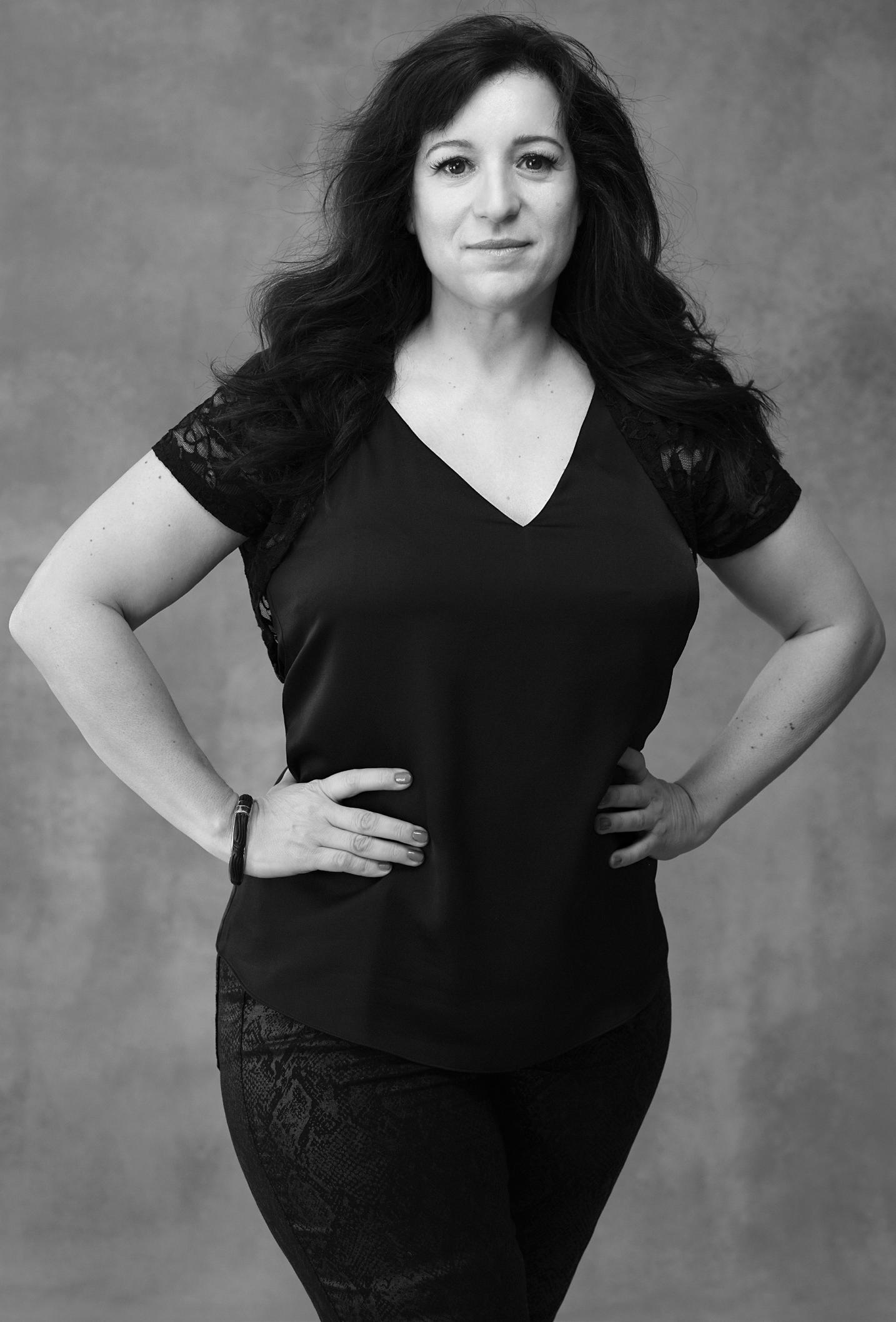
Drag has sashayed into the mainstream and Hamilton’s drag queens just keep being fierce.
57/ ALL SEWN UP
Theatrix Costume House jams more than 50,000 costumes, wigs and accessories in a former church on Kensington Avenue North.
62/ A GOLDEN DIRECTION
Brad Germain’s new band Golden Feather is influenced by Steely Dan, Grateful Dead and others while exploring a ‘jam band’ approach.
t he steel industry, Part of h a M ilton’s lifeblood, has endured 50 years of tur M oil. b ut things are turning around as the world discovers the i MP ortance of steel in the fight against global war M ing.

4 HCM MAY/JUNE 2023
ON THE COVER: KENADIE ST. JAMES / KARMA KAMELEON
Photographed by Marta Hewson for HAMILTON CITY Magazine | Photo Assistants: Katelyn O’Neil and Jerrold Hewson | Art Direction: Will Vipond Tait
Photogra P her Marta h ewson is continually reinventing her career behind the ca M era.
pg21
PULLING FOCUS
pg30
STEEL TURNS GREEN
MAIN ATTRACTIONS
LAND ACKNOWLEDGEMENT



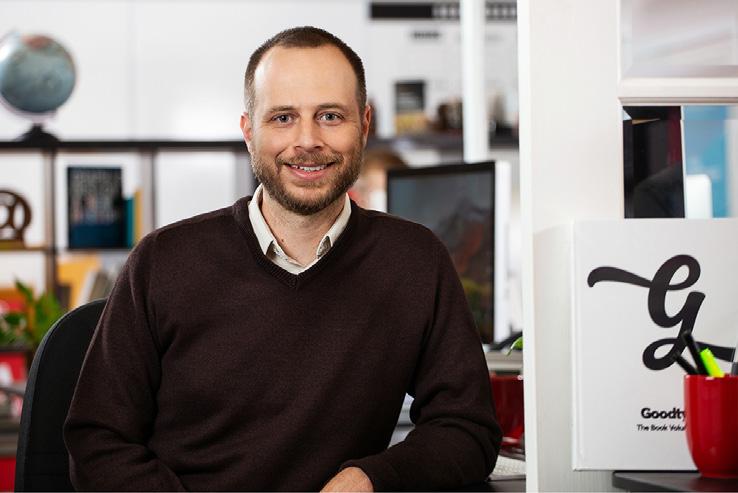


The City of Hamilton is situated upon the traditional territories of the Erie, Neutral, Huron-Wendat, Haudenosaunee and Mississaugas. This land is covered by the Dish With One Spoon Wampum Belt Covenant, which was an agreement between the Haudenosaunee and Anishinaabek to share and care for the resources around the Great Lakes. We further acknowledge that this land is covered by the Between the Lakes Purchase, 1792, between the Crown and the Mississaugas of the Credit First Nation. Today, the City of Hamilton is home to many Indigenous people from across Turtle Island (North America) and we recognize that we must do more to learn about the rich history of this land so that we can better understand our roles as residents, neighbours, partners and caretakers. Both the National Day for Truth and Reconciliation and Orange Shirt Day take place on Sept. 30 and recognize that at least 150,000 Indigenous children from across the country were forcibly separated from their families and their communities.
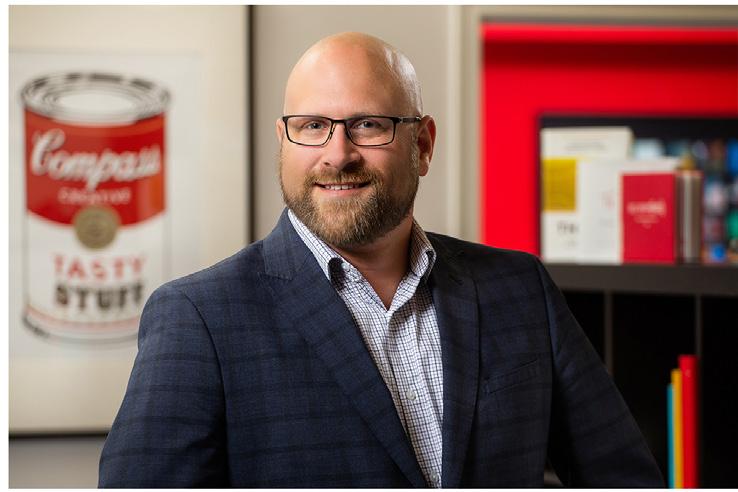
MAY/JUNE 2023 HCM 5
7/ CITY LIFE 17/ MADE IN HAMILTON 39/ FOOD + DRINK 47/ ARTS + CULTURE REGULAR STOPS 8/ FOR THE LOVE OF HAMILTON 15/ LIFE IN THE CITY 56/ HAMILTON READS
pg40
It may be I llegal to keep hens and roosters w I th I n the c I ty l I m I ts of h am I lton, but backyard fowl are a great add I t I on to urban l I fe.
CHICKENING OUT
40 years of the collection
June 16 — October 8, 2023
Opening Reception, June 15, 6:30 – 8:00 pm



ART GALLERY BURLINGTON | AGB.LIFE
2022
Brendan Lee Satish Tang, Manga Ormolu Version 4.0r, 2013, Ceramic and mixed media, 16 × 13 × 20 inches. Purchased in part through the support of the Elizabeth
The AGB is generously supported by the Ontario Arts Council and the Canada Council for the Arts.
A golden mission
THE HAMILTON LITERACY COUNCIL IS MARKING 50 YEARS OF EMPOWERING HAMILTONIANS WITH READING, WRITING AND NUMERACY SKILLS.
The Hamilton Literacy Council (HLC) is probably one of the best-kept secrets in the city. Even though nearly half of Canadian adults have inadequate literacy skills, most who are struggling don’t advertise that they’re seeking – or have found – help.
So much of the life-changing work of the HLC over the last half-century has stayed under the radar.
HLC offers free training in reading, writing and math to English-speaking adults in Hamilton. It also provides digital literacy training, including computer basics and iPads for seniors. To date, it has helped more than 11,000 Hamiltonians develop and improve their literacy skills.

Poor reading, writing and numeracy skills among Canada’s adult population has created a literacy gap that has wide-ranging implications for our economy and democracy. The work the HLC does helps empower individuals, which in turn benefits their families and the wider community.
This year marks the organization’s 50th anniversary after
incorporating as a registered non-profit in 1973. The HLC started as a grassroots movement focused on “literacy as a human right” and was mainly run by women from the local Lutheran church. From its tutors to its board members, the organization has always remained focused on volunteerism. It follows a popular “each one, teach one” mantra that says when someone learns how to read or write, it becomes their responsibility to teach someone else.
Earlier this year, the HLC opened a second office at Upper Wentworth and Fennell to serve the Mountain (its primary office is in the YWCA Hamilton building on MacNab).
The organization will mark 50 years with a new website and a celebration of volunteers and students at The Gasworks in June. n
If someone you know needs help with reading and writing, please contact info@hamiltonreads.ca
The HLC is also accepting new volunteers for the fall season: hamiltonreads.ca/volunteer
MAY/JUNE 2023 HCM 7
The h amilTon l i T eracy c ouncil has been helping e nglish-speaking adulTs improve T heir reading, wri T ing and numeracy skills since 1973 photo: supplied For the F ull F eature story online, scan the qr code
FOR THE LOVE OF HAMILTON
THIS REGULAR FEATURE WILL HIGHLIGHT PEOPLE, FROM ALL WALKS OF LIFE, WHO HAVE EMBRACED HAMILTON AS THEIR NEW HOME.
DIRK FRANCIS AND KAREN VAN HOECKE

who They are: The steelmaker and the painter are both engineers.
inTerviewed by: Meredith MacLeod
phoTo by: Joe Bucci
hamiltoncitymagazine.ca
scan the qr code to read the full q+a online.
8 HCM MAY/JUNE 2023
DIRK FRANCIS AND KAREN VAN HOECKE became Hamiltonians about a year ago when Francis officially took on his new three-year post as vice-president of manufacturing at ArcelorMittal Dofasco.
The couple moved from their native Belgium with their son Bengt, 19, who is pursuing a bachelor of technology degree at McMaster University. He wants to be an engineer like his parents. The family lives in the Riverdale East neighbourhood of Stoney Creek.
STEEL IMPORTS
What are some differences between Canada and Belgium?
DF: A big difference is that university is 10 times more expensive here. That was a surprise. Another difference is all the paperwork to fill out here. For university, for driver’s licences, for everything. We don’t have as much at home.
In Belgium, everyone has two bikes. Here, everyone has two cars.
And here, people are very positive. Belgians and Germans are cooler people.
Why did you decide to come to Canada?
DF: It wasn’t on my bucket list to come to Canada but this opportunity came up at ArcelorMittal Dofasco. It is one of the top three performers within the global company and a chance to expand my responsibilities to all manufacturing operations. When I first came to visit the plant, everyone was so open and warm, even though it was secret that I was joining ArcelorMittal Dofasco. It was a chance to learn another culture for me and my family and a great opportunity for my son to go to university in Canada.
What were your first impressions of Hamilton?
DF: I had never heard of Tim Hortons before I came here but I saw all these people walking around drinking from coffee cups or lining up in their cars in the morning. The truth is, we are doing the same thing now. In Belgium, everyone just drinks coffee at home.
Canada doesn’t have the history that Europe has. It’s a young country but the nature is amazing here. You don’t have to drive far to see nature.
KVH: My first impression is that it’s a beautiful place here but there are parts that could be better taken care of so that it’s even more beautiful.
What in Hamilton surprises and delights you?
DF and KVH: The waterfalls. We didn’t know how many there are here. We’ve been to the Devil’s Punch Bowl, Sherman Falls, Webster’s Falls, Tiffany Falls. They have been beautiful. We were also surprised by the fall colours. We don’t get that at home.
Hamilton needs more …?
DF: Bike infrastructure. Biking is dangerous in some places here. More biking would make the city more liveable. And Hamilton needs more pubs. Every street has five pubs at home.
KVH: More ability to ride a bike. People respect bikes here but drivers don’t expect to see them.
Hamilton needs less …?
DF: Poverty. There are so many people who are struggling and on the streets. It’s typical for cities, but more supports are needed.
KVH: Homeless people. I wasn’t expecting to see that here.
MAY/JUNE 2023 HCM 9
IF YOU’D LIKE TO BE FEATURED IN FOR THE LOVE OF HAMILTON, PLEASE CONTACT meredith@hamiltoncitymagazine.ca
/continued online
REDISCOVERING THE 15-MINUTE CITY
IT ISN’T A NEW CONCEPT BUT IT’S A CHANCE TO REFOCUS ON WHAT MAKES A CITY A WALKABLE, LIVABLE AND SUSTAINABLE COMMUNITY FOR EVERYONE, SAYS URBAN PLANNER PAUL SHAKER .

The concept of the 15-minute city is a hot discussion of late, primarily because of misinformation surrounding what it means. Nothing illustrates this point more clearly than a recent video of an Edmonton urban planner that went viral. He was addressing a protest on the streets of his city about the 15-minute city and plans the municipality had for adopting the concept. It was a surreal video, not the least because of the conspiracy theories that were being lobbed at the planner. Questions such as:
What is the real agenda behind the 15-minute city?
Are you going to build walls around our neighbourhoods?
Are you going to restrict the movement of citizens between neighbourhoods?
Each time, the planner took time to dispel the
misinformation, but the whole exchange revealed that, to the crowd at least, this current buzzword in urban policy was something new, foreign and sinister. Which is surprising, because it is none of these things.
So first of all, what is the 15-minute city? Simply put, it is a community development approach with the goal that everyone living in a city should have access to essential amenities within a 15-minute walk or bike ride. Think schools, parks, recreational facilities, and neighbourhood businesses for a variety of daily needs. The term was coined by urbanist Carlos Moreno and first came to prominence in 2021 in Paris where it was championed by current Mayor Anne Hidalgo, who made it a central part of her vision of the city’s future. Since then, the popularity of the term has spread to cities around the world.
10 HCM MAY/JUNE 2023
However, while the term is new, the concept is not, as the idea of “complete communities” has been around for quite some time. In fact, it’s based on an urban form that many cities once had, but lost after rapid decentralization and suburbanization that was accompanied with widespread adoption of the automobile. The whole movement of downtown revitalization that swept across North America in the 1990s and 2000s was a step towards restoring a more livable city. More recently, what supercharged the discussion was the changes to city life due to COVID-19.
The pandemic changed the city dynamic overnight, with people suddenly working from home. This made your local neighbourhood even more important as a centre of community activity to help provide a variety of services to sustain daily life, whether for living, working or recreation. So with this shift in home-work lifestyles likely to become permanent to some degree, cities have started to plan communities to reflect this new reality.
Enter the 15-minute city. For a municipality like Hamilton, this approach brings a host of benefits, starting with increased quality of life and extending to more equity between neighbourhoods. Importantly, what the 15-minute city would actually mean for neighbourhoods is different depending on each neighbourhood’s circumstances. In that sense, the building of 15-minute cities should be a deeply participatory process that asks the individual communities what they have, what they value, and what they need. Rather than being a conspiracy about control as some of the protestors claim, it’s actually a chance for a more democratic city.
But what would it actually mean to create, or in some cases recreate, the 15-minute city? Let’s take a look at the issue from a few perspectives starting with walkability, or the ability to get around on foot. Some issues of walkability are experienced city-wide, like street safety. To address this, changes to speed limits and better street design are required in every corner of the city. However, in other respects, there are differences. Older urban areas are by nature denser, with better potential to be walkable compared to their suburban counterparts. Therefore as a priority, improved walkability in our suburban communities should be a primary goal. While this might sound like a vague
idea, it could concretely start with the goal to have sidewalks on every street.
Another hallmark of the 15-minute city is having local shops and services nearby, usually in a sustainable local business district within walking distance of home. The local coffee shop, restaurants, bars, a grocery store, all contribute to quality of life. While municipal government cannot force businesses to open in specific parts of the city, they can help create attractive conditions to make it possible. First and foremost, businesses need customers, so encouraging more people to live within walking distance of a business district is something that should be promoted. This can be accomplished by encouraging more gentle density in existing neighbourhoods. Gentle density, sometimes called the “missing middle,” includes a diversity of housing forms between detached homes and high-rises, such as semi-detached homes, townhouses and low-rise apartments. This issue is of particular interest of late because of the increased demand for housing, therefore revising our plans and antiquated zoning bylaws to permit more gentle density is another important step in reaching the goals of the 15-minute city. Another consideration is parks and outdoor recreational space. In contrast to the suburbs, park space is not as plentiful
in many older urban areas due to space constraints, a situation that is only going to increase with a boom in high-rise construction on the horizon. Thus, investing in urban green space and other recreational opportunities should be a goal. Even if new green space might not be as readily available in older urban areas, there are other opportunities, such as the extensive alley network, that could be leveraged to create more recreational space. As with walkability, the local solution might vary, but the citywide goal remains the same.
Finally, neighbourhood schools are another important part of a 15-minute city. Elementary schools provide a focal point for daily life for thousands of students and contain recreational space that the adjacent neighbourhoods can use outside of school hours. When a school is closed down, it can accelerate a downward spiral for a neighbourhood. Conversely, when a school opens, or is reinvested in, it can make a neighbourhood a magnet for new people. Therefore, ensuring investment in our neighbourhood schools, so that they remain open, is another important part of creating complete communities across our city.
As mentioned, in many ways, this issue is not about creating something new. Rather, it’s about recreating or rediscovering something that is already there. Across Hamilton there are examples of what the 15-minute city looks like. Picture the downtowns of former municipalities including Ancaster, Dundas, Stoney Creek and Waterdown. These downtown business districts are surrounded by walkable neighbourhoods with parks and schools nearby. This is also true for parts of the previous city of Hamilton, be it Westdale, Locke Street, Concession Street or Ottawa Street. While these areas have their various strengths and/or challenges, they have the foundational elements of what can make a complete community.
Three years on from the onset of the pandemic, a new normal is emerging that includes an era of hybrid work that will keep people more tied to their neighbourhoods on an ongoing basis. Within this new reality, there is all the more reason for Hamilton to rediscover the 15-minute city as the basis for community planning moving forward. n
MAY/JUNE 2023 HCM 11
Paul Shaker is a Hamilton-based urban planner and principal with Civicplan.
The pandemic changed T he ci T y dynamic overnigh T , wi T h people suddenly working from home. This made your local neighbourhood even more impor T an T as a cen T re of communi T y ac T ivi T y T o help provide a varie T y of services T o sus T ain daily life.
Raising voices in song and art
INCITE FOUNDATION FOR THE ARTS SUPPORTS THE CONTRIBUTIONS OF MUSICATA, HAMILTON’S VOICES AND THE CARNEGIE GALLERY.

The Incite Foundation for the Arts has contributed more than $5 million to 30 Hamilton-area organizations in grants from $2,500 to $150,000 since it was founded in 2011.
It is the legacy of the late Carl and Kate Turkstra who believed the arts are key to quality of life and critical to the future of Hamilton. And they believed anyone, regardless of circumstance, should be able to enjoy and pursue music, theatre and visual art.
HAMILTON CITY Magazine is showcasing the incredible, creative and talented recipients of Incite grants. Here we begin with Musicata, Hamilton’s Voices and the Carnegie Gallery.
MUSICATA, HAMILTON’S VOICES
Formerly known as The John Laing Singers, Musicata, Hamilton’s Voices is celebrating its 40th anniversary season. Since becoming artistic director in 2011, Roger Bergs has built on John Laing’s solid foundation of choral excellence, moving the choir in adventurous new directions. The mission is to bring the warmth and passion of live choral music to a wide-ranging audience and collaborate with up-and-coming local musicians.
“Musicata is a dynamic and innovative chamber choir presenting choral music that brings a fresh vision to live concerts. Wrap yourself up in the energetic and nuanced blend of 25 accomplished voices. Discover new favourites and hear classics renewed and reborn. Let our music carry you to places
that you have never experienced,” says Bergs.
“We are very grateful for Incite Foundation grants that allow us to subsidize the costs involved.”
Church of the Ascension in downtown Hamilton (Forest Avenue and John Street) is the choir’s new performance space and together, Musicata hopes to promote this space as a hub for the arts in Hamilton.

THE CARNEGIE GALLERY
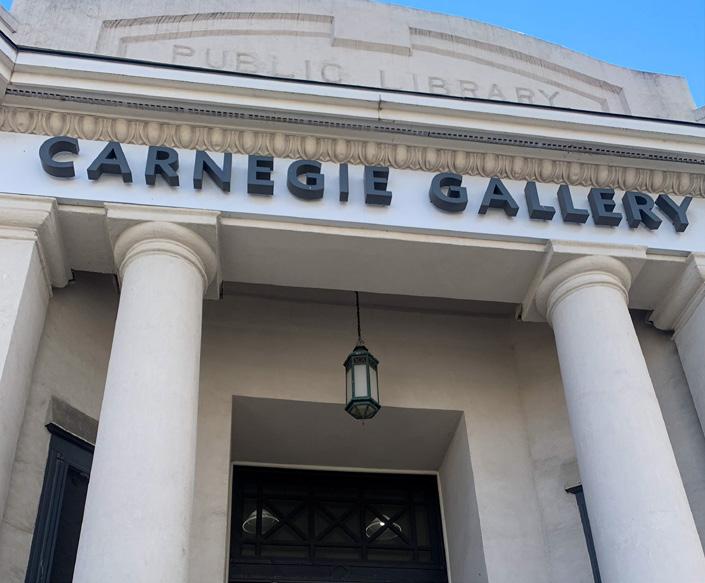
The Carnegie Gallery is a vibrant, nonprofit, artist-run gallery nestled in the heart of historic Dundas. Established in 1980 as an outlet and exhibition space for artists and craftspeople, the gallery features the area’s best fine art and craft for sale in its shop, exhibitions, and online store.
Housed in the original 1910 Dundas Library building, a new addition was added in 2013, known as The Barber Atrium, seamlessly blending the old architecture with the new. Thanks to the support of many members, volunteers, and funding organizations such as the Incite Foundation, the Carnegie is proud to have recently celebrated its 43rd anniversary in the arts community.
Welcoming more than 20,000 visitors annually, the Carnegie is a dynamic cultural centre and tourism magnet for the town of Dundas and surrounding area. Featuring the work of 79 artists, and a yearly schedule averaging 20 monthly exhibitions, the Carnegie also programs independent lectures, artist talks, a lecture series, children’s art classes, bus trips, music concerts, and even a garden tour.
“We are tremendously appreciative of the funding we receive from Incite, which allows us to organize our annual Arts Dundas Weekend,” says Marla Panko, Carnegie curator.
“This event has been bringing together local arts organizations in celebration of visual art, craft, ceramics, theatre, music, and poetry for 36 years. We have also been able to introduce a new series of free, exhibiting artist talks to the public. So with this generous support, we not only connect our artists to one another, but also provide outreach programming that enriches the broader community at large.” n incitefoundation.ca
12 HCM MAY/JUNE 2023
THIS CONTENT IS BROUGHT TO YOU BY THE INCITE FOUNDATION FOR THE ARTS
photos: submitted
Musicata, Ha M ilton’s Voices is celebrating its 40 t H anni V ersary. scan the qr code to read more about Inc I te


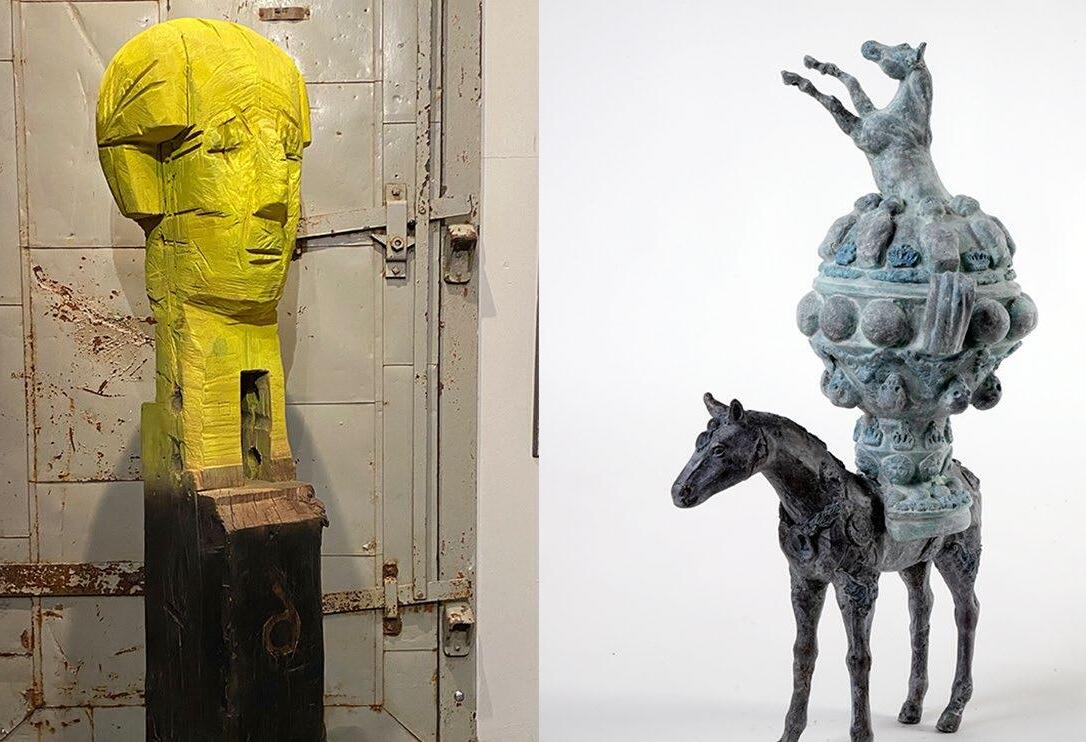







MAY/JUNE 2023 HCM 13 a project of
Sculpture www.bwst.ca April 22 to June 2 1.5 KM TRAIL CONNECTING THE ART GALLERY OF BURLINGTON, SPENCER SMITH PARK , DOWNTOWN BURLINGTON AND CITY HALL . 30 ARTISTS DANYLIW MANN sponsored by DESIGN & DEVELOPMENT Digital Process Transformation Digital Marketing Web Design & Development Mobile Apps 1 Summers Lane, Hamilton ON, L8P 4Y2 contact@2gen.net INTERACTIVE 905-308-9155
Dan Lawrie
Not to be Missed
BETTER ON A BOARD
Despite where you stand on the divisive subject of the butter board, there is no denying that an artful spread of tasty treats taste better when displayed upon a gorgeous rustic board – we eat with our eyes first, they say. Hew a board of your own to take home, and learn the art of charcuterie styling at the Art Aggregate/McCormack Timber Supply Co. workshop – Boards Beer & Bites. No woodworking experience is necessary, and you’ll come away with new skills suitable for both the woodshop and the kitchen. Like any school day, students get a snack, but because they’re grownups, it’s a nibble of charcuterie with a beer pairing from Clifford Brewing Company. May 28, 12-398 Nash Rd. N. artaggregate.ca
BUOYED BY HAMILTON
Viewing any city’s skyline from the water is a magical thing: the new nautical perspective provides a mysterious, almost storybook vantage point. Our Hamilton is no different, and when viewed from the water, with its industrial, commercial, and residential areas on display in one glance, it’s staggering to see the beautiful scope of what the city offers. Intrigued, but no boat? No problem. Now in its 19th season, The Hamiltonian – a 12-passenger sightseeing vessel – offers a leisurely 50-minute narrated tour of the Hamilton Harbour, where guests earn their sea legs while learning about a different side of the city. Tours depart from Pier 7 docks. hamiltonwaterfront.com
GIGS GALORE
Every year, music fans add the Sound of Music Festival to their gratitude journal, for not only is the festival essentially a multi-day, nonstop concert, general admission is free (with upgraded tickets available for purchase). Some of the big draws coming to Spencer Smith Park’s waterfront main stage this year include Flock of Seagulls, The Struts, and Default, and no shortage of renowned talent is scheduled to appear at two other nearby venues (including Hamilton’s Redhill Valleys). Between sets, grab a bite, take a spin on the midway, and hit the Streetfest on Brant for a bit of fun fit for the whole family. June 15-18, Spencer Smith Park, Burlington. soundofmusic.ca
GO FOR A BEER RUN
When it comes to exercise, different things motivate different people, and if you are motivated by either a supportive group or beer – or both – Fairweather Brewery has you covered. Open to runners of all abilities, the Fairweather Runners running club meets every Sunday morning for an easy, friendly 5K group run. You’re welcome to head home for a well-earned hot shower afterwards but consider lingering a bit at the brewery instead, bonding with your new gang, swapping stories about your favourite routes, newest gear, and latest injuries. Sundays, 10:30 a.m. fairweatherbrewing.com
hamiltoncitymagazine.ca
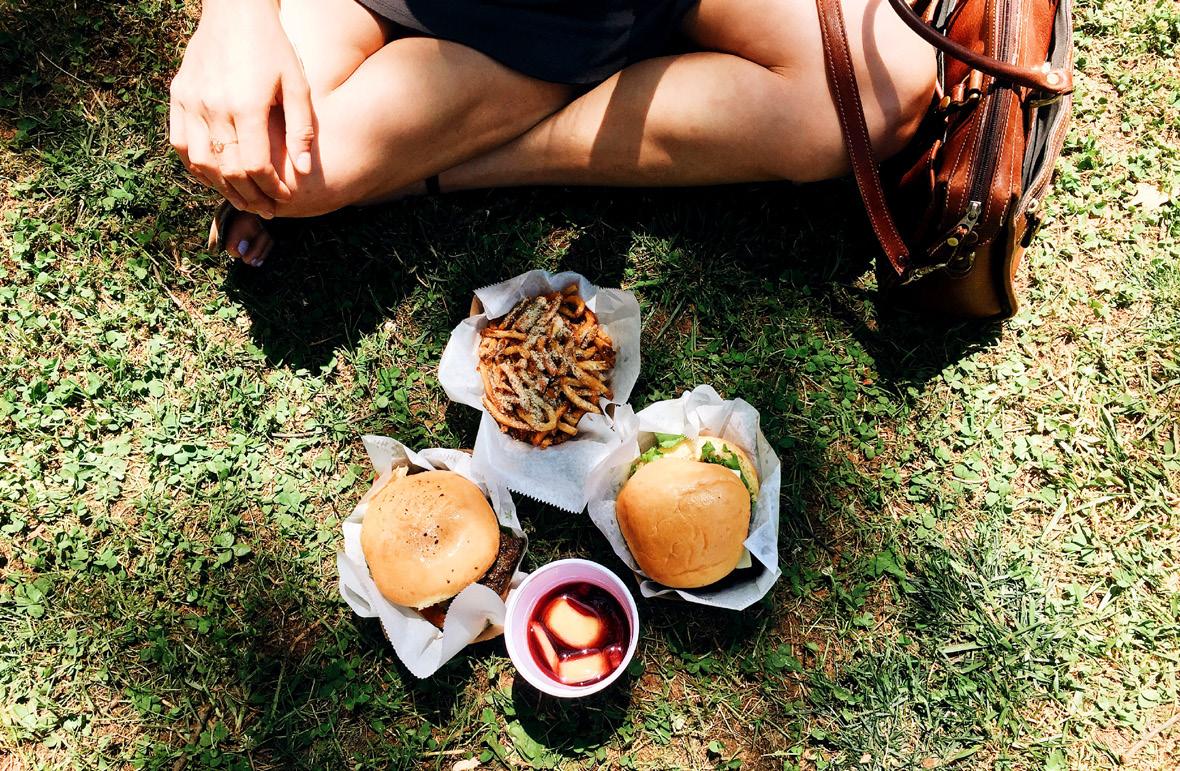
scan the qr code Plan your weekend, your week and your month with our t hings to d o listings!
TREE FOR ALL
Get up to something new this spring at Treetop Trekking at the Binbrook Conservation Area. Visitors looking for a bit of adventure can test their skills – and bravery – on an array of suspension bridges, Tarzan swings, or zip lines that promise to offer more than the usual walk in the park. Rest assured that the younger crew is not left behind in the trees, as a lower-to-the-ground course is available for visitors five to eight years old. For a more reflective visit with less screaming, the park will also offer a forest bathing experience, where participants are led by a certified forest therapy guide who will help them connect with nature, and themselves, on a new, deeper level. treetoptrekking.com/park/hamilton/
HIDING IN HAMILTON
When you’re searching for a new activity to do with your pals, family or even co-workers, look no further than Hamilton Hopper – an app-lead scavenger hunt by Let’s Roam. Available in cities all over the world, the 90-minute to two-hour hunts are equal parts tour and game. Each are customized to the number and ages of participants and are a perfect way to have fun and get the competitive juices flowing. With an assortment of challenges popping up along the way – those that are photo-based are quite literally “a picture or it didn’t happen” – the tours offer a perfect opportunity to seek out, and hopefully find, some new aspects of the city that have been hiding in plain sight this whole time. letsroam.com
14 HCM MAY/JUNE 2023
The days are getting longer and the nights are getting warmer, so late spring is a great time to explore your city. With that in mind, here are a few of our favourite local happenings.
Hamilton
LIFE IN THE CITY
From festivals and films to galas, galleries and gigs, Hamiltonians love to have a good time and these photos are definitely worth a thousand words. HAMILTON CITY Magazine was there – were you?



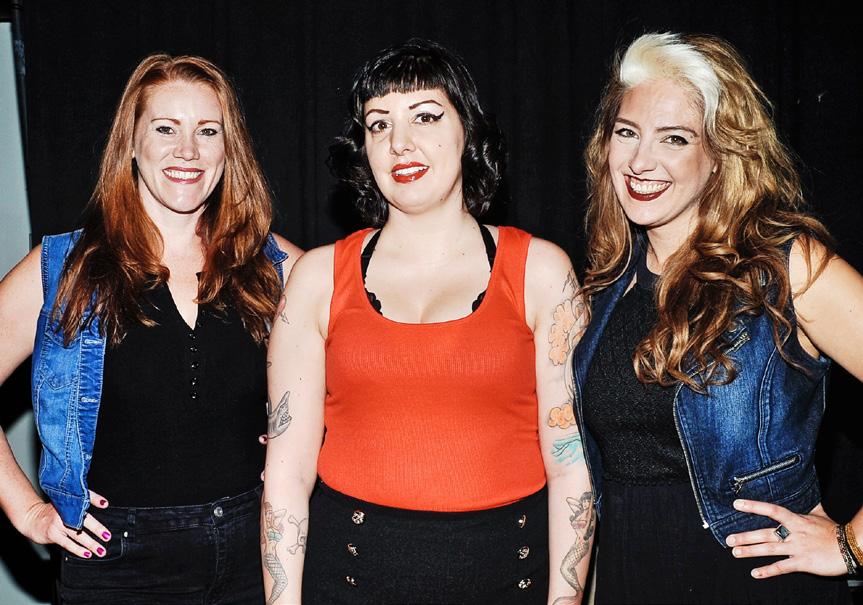



photos By B rent perniac +
To check ou T more phoTos, scan T he qr code

MAY/JUNE 2023 HCM 15
Donna Waxman
1. Glass Tiger, from left, Carmela Long, Al Connelly, Alan Frew, and Sam Reid headlined the Charity of Hope Gala, March 24 at Carmen’s Banquet Centre.
2. Headliner Harrison Kennedy at the Jazz Up the Winter Blues, Ancaster Mill, March 6.
3. Brit Floyd, The World’s Greatest Pink Floyd Show, FirstOntario Concert Hall, April 12.
4. Frank Salvatore, MP Filomena Tassi and Mayor Andrea Horwath at the CYO Dinner, Carmen’s Banquet Centre, March 31.
5. DJ David Murkovich & Amy Lombo at the A Side B Side second anniversary, The Casbah, March 18.
6. The Barettas: Lauren Small, Katie Bulley and Justine Fischer at Stonewalls, April 15.
1 3 6 8 7 5 2 4
Fashion Week Gala Fashion Show, The Music Hall, Feb. 18: 7. Gabriela Amaral, Ken & Krystal Biehler, Kamryn Mackie. 8. Cieran Sheard

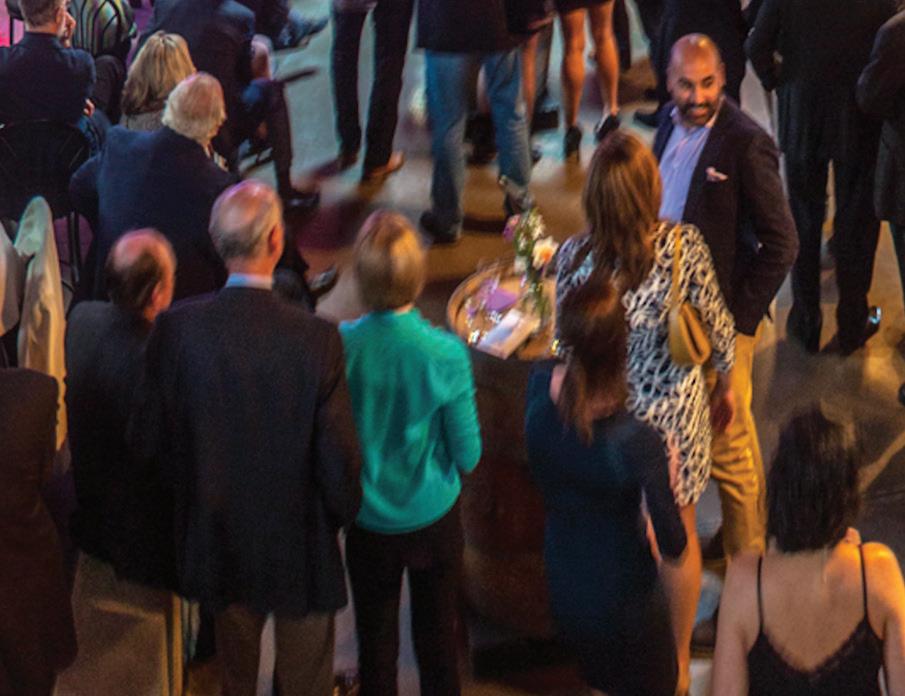























16 HCM MAY/JUNE 2023
Village people
MAMARADERIE IS A PLATFORM FOR MOMS BUILDING NETWORKS ONLINE AND IN REAL LIFE.
It takes a village to raise a child, the old adage goes, but where does one find a village these days? That’s where Mamaraderie (rhymes with camaraderie) comes in.
The online platform helps moms of all kinds build friendships, support networks and community. After all:
“Motherhood is hard, but you don’t have to be in it alone.”
Founders Ela Wojciechowska and Shelbi De Silva are transplants to Hamilton via Toronto. Each were entrepreneurs independently developing platforms catering to mothers.

After being connected by a local mom familiar with both of their businesses, the two quickly decided during the deep isolation of the pandemic that it made sense to collaborate.
“Moms couldn’t have playdates or meetups. Many were on mat leave for the first time or were newcomers to Hamilton who didn’t know anyone,” says Wojciechowska. She and De Silva created a six-month plan.
While there are plenty of mom-focused groups on social media, what the two decided was missing was a platform geared to matching local moms with similar family circumstances, careers, interests and values.
“We really want the technological experience to get moms
offline to meet at the park, have a coffee, make a playdate. It’s about creating meaningful relationships, not time spent online,” says Wojciechowska, a mother to three.
Mamaraderie features searchable member profiles, themed chat groups, clubs, and discounts offered by more than two dozen vendor partners.
And since launching, Mamaraderie has hosted more than 60 events, including those for mom and baby together and those meant for mom alone.
Mamaraderie – there is a $99.99 yearly membership fee and a free model – invested in a proprietary web app and is slowly expanding beyond Hamilton, with an eye to a national, even global, presence one day.
“We decided just over a year ago that we would regret it if we didn’t go bigger with our vision,” says De Silva, a mother of two. That’s paid off in many ways, including landing an invitation to participate in the Collision tech conference in June in Toronto.
It’s thrilling that moms within the Mamaraderie universe have stepped up to help, says De Silva.
“They see the value in what we are doing, which is incredible. We really feel the stars are aligning for us.” n
MAY/JUNE 2023 HCM 17
Ela WojciEchoWska, lEft, and shElbi dE silva arE thE foundErs of MaMaradEriE, a platforM gEarEd to MoMs of all kinds.
photo: Ian p ett I grew
MADE IN HAMILTON IS SPONSORED BY CITY OF HAMILTON ECONOMIC DEVELOPMENT INVEST IN HAMILTON
Preaching TO THE CONVERTED
RING THE BELLS, HAMILTON’S CHURCH CONVERSION GAME IS HEATING UP. By
It all started with a parade. When they laid the cornerstone at St. Thomas Anglican Church, Victorian Hamilton threw a party.
To celebrate the new church at Main Street and West Avenue, the band of the 13th Battalion marched on parade, along with organizations like the Masonic Fraternity, the St. George’s Society, and the Irish Protes-
Sarah Sheehan
tant Benevolent Society. The boom spurred by the Great Western Railway had brought new Hamiltonians to the eastern part of the city — today’s Stinson neighbourhood — and church-goers were tired of taking the wooden sidewalks to services on James Street.
When 16 West opened last summer, the festivities were more muted. But make no
mistake: the much-anticipated conversion of St. Thomas into 19 rental units was true cause for celebration. Thanks to the vision of fairtrade entrepreneur and owner Tal Dehtiar, the loft rentals in the former St. Thomas Anglican are Hamilton’s first church apartments.



Speaking with Dehtiar about 16 West, it’s clear the project is firmly grounded in sustainability. “I love the building, I love the area,” says Dehtiar. Without outside investors, he’s in for the long term, and maximizing reuse at the site was a guiding principle.
Based in Oakville, Dehtiar is the founder and CEO of Oliberté, a sustainable fashion B Corp. Until 2019, his company operated the world’s first Fair-Trade Certified shoe factory, in Addis Ababa, Ethiopia. 16 West is his first major redevelopment project: 19 apartments in a designated church and attached Sunday school. Even amid pandemic materials shortages, the place was move-in ready in under a year, thanks to a nimble approach and locally sourced labour. 16 West also represents an update of the beloved, older housing model
18 HCM MAY/JUNE 2023
16 West is a conversion of s t. t homas a nglican c hurch into 19 bright and airy rental units. photos: cj martin photography
of mid-rise, often family-owned apartment buildings. Where another developer might have sold the units for a profit, as luxury church condos, for Dehtiar, the building is a legacy for the next generation. “I wasn’t looking to buy and sell,” he says, but to “keep it for my kids and grandkids.”
The Dominion of Canada was just two years old, and Stinson was a prosperous new neighbourhood, when construction started on St. Thomas Anglican. Albert Harvey Hills, an important Hamilton architect best remembered for MacNab Presbyterian, was commissioned to design the Gothic Revival church. A few years later, Hills also designed the Sunday school wing (later used as the parish hall), and subsequent alterations grew the footprint along West. Workers quarried limestone from the nearby escarpment, and built on land donated by Ebenezer Stinson, the Irish-born merchant and one-time parish priest who gives his name to the neighbourhood.
Today, this part of Stinson is a typical downtown mix of old and new. 16 West stands on Main Street between Canadian Tire and Anytime Convenience. The Indigenous community has a strong presence in the area, with a new Sacajawea housing development to the south and, where Hunter meets Victoria, a retired couple maintains the First Ojibwa Monarch Conservatory Garden. Across Main, a new-media company operates out of the Blachford & Wray building, once home to a 1920s funeral parlour. On King East, there’s a new day spa in the Meakins & Sons brush factory (where the old altarpiece was made), and Core Urban is renovating the adjacent Red Cross building for Mission Services. Local residents will be steps from the future Wellington LRT stop.
Inside, Dehtiar worked with Hamilton architectural design firm R&R Designs to create airy, monochrome spaces structured around the original features. There are no second-floor units; the deconsecrated sanctuary is sliced like a cake, giving 36-foot ceilings — and a steep climb to the sleeping loft — in the main building. (The conversion also includes two accessible units.) In the common areas, there are vaulted ceilings overhead, quatrefoil-patterned linoleum underfoot. Original trim, Gothic tracery, panelling, and trusses are all painted gallery white, setting off the brilliant colours of the stained glass. In the Altar suite, tenants can enjoy a large-scale, 1921 stained glass window that’s the last
work of master designer Robert McCausland. Church lofts are rare; the chance to rent one is even rarer. The larger units rented within weeks. By the time of my early-fall tour, only three units were left. Guide Rob Hansen, maintenance technician with Found Spaces Inc., explained a big part of the appeal: “The bones are old, but the systems are brand new.”
For decades now, savvy developers have been snapping up vacant churches and charging a premium for the unique spaces they can offer: soaring ceilings, fine architectural details, in a shell that was built to last. Standouts in other cities include a Maastricht bookstore, Ottawa’s Bluesfest HQ, pubs in Glasgow and Pittsburgh, even a skatepark in St. Louis. On the surface, Hamilton seems like a holdout to this trend. But look closer, and you’ll see that dozens of places of worship have been repurposed organically, in a characteristically Hamilton way: to date, most conversions here are for cultural, commercial, or community use. (Check out the sidebar.)
The first church lofts in the amalgamated city are the St. Thomas Lofts in Waterdown: a century-old Catholic church converted in 2010 by Halton Heritage Realty with Cynthia Zahoruk Architect. Downtown, the Connolly project, on the site of the mostly-demolished James Street Baptist, could have been the first church apartments in the old urban area — if not for delays. Hamiltonians have become understandably wary of high-profile condo projects like the Connolly: after the bankruptcy of the original developer, eight years in limbo and one cameo in The Handmaid’s Tale, the site has changed hands for a third time, sold to a consortium.
In contrast to the Connelly’s unedifying
FULL OF POTENTIAL
Three former churches have amazing potential to be given new life through reuse.
ST. GILES
85 Holton Ave. S.
Once slated for demolition, St. Giles is Stewart & Witton’s masterpiece. Thousands signed a petition to keep it standing – and local advocates know it would make a great community hub. In 2021, a donor generously offered funds for reuse that could help make those plans a reality.
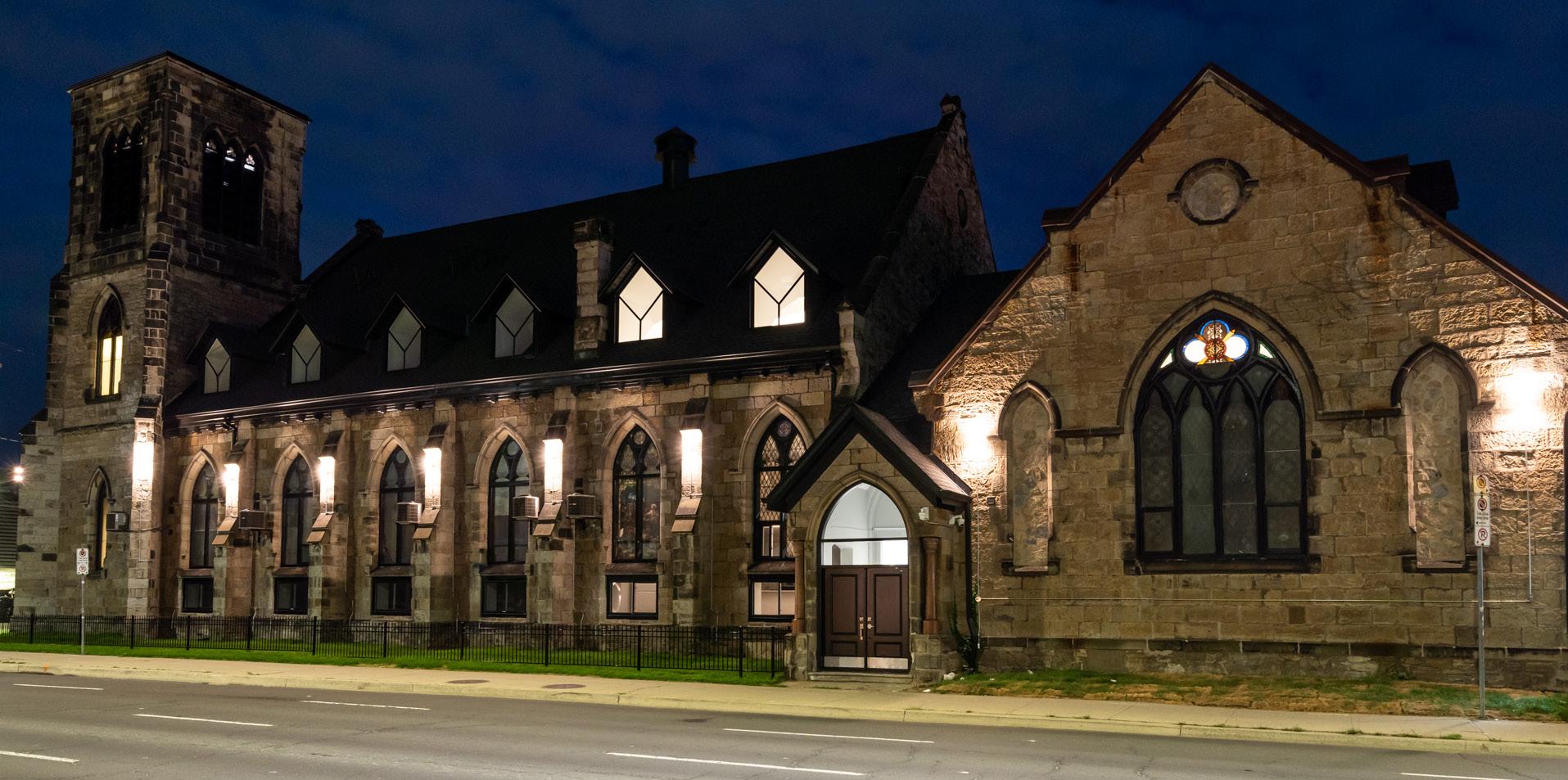
GRACE LUTHERAN
1107 Main St. W.
Heritage advocates want to see the 64-yearold church sanctuary incorporated in some way into a proposed 15-storey condo that has received approval by city council. The developers — IN8 Developments and Westdale Construction — plan to feature its limestone facade in a garden.
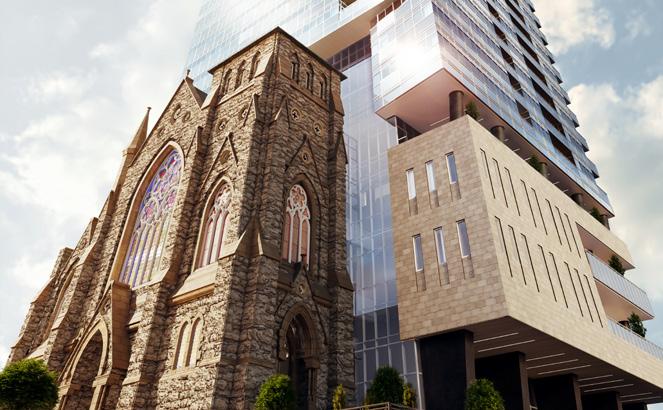
THE CONNOLLY
98 James St. S.
The long-planned and much-delayed downtown condo project incorporates what remains of James Street Baptist. Currently on its third set of owners, will mcCallumSather’s 2014 design, below, stand the test of time?
MAY/JUNE 2023 HCM 19
/continued on next page
The conversion of a 14,000 -square-fooT s Tone church on Wes T avenue aT Main sT ree T Was co M ple T ed in under a year.
ruin on James South, other church reuse projects forged ahead during the pandemic –showcasing the quick turnaround that’s possible with adaptive reuse. St. Mark’s Centre and Indwell’s Stonehouse Apartments are expected to open in 2024, both with sanctuaries refurbished as community space. Gibson’s St. Giles and Westdale’s Grace Lutheran also present exciting possibilities for reuse.
Affordable infill housing is Indwell’s plan for its first Hamilton church project: the Stonehouse Apartments beside Wentworth Baptist, designed by Hutton & Souter. The Christian charity bought the property in 2021 and, according to development manager Sylvia Harris, they’re renovating the sanctuary “for program, community, and church use.” The church opened in 1924, meaning the projected opening date is also the building’s centenary. Rezoning awaits the new term of council. In historic Durand, the City of Hamilton is repurposing the 1878 St. Mark’s Anglican as a community hub in partnership with Burlington’s ATA Architects, and thanks to a grant from the Patrick J. McNally Charitable Foundation. Green space is an integral – and designated –part of the storied heritage site, which the City purchased in 1994 to save it from demolition.
Back at 16 West, Dehtiar wonders why the whole building wasn’t designated. “It probably should be.” Far from hurting the bottom line, he says, working with a protected heritage property is good business. “From a financial standpoint, (it’s) significant”; the savings from City incentives went to “ensure we’re keeping the look and feel of the building.” Nothing was sold for salvage; instead, what couldn’t stay was given away locally. Pews and doors were donated; spare stone went to neighbourhood gardens. The bell tower is locked for now. He’s keeping it for his kids, in case they want to ring the bells. n
LIKE A PRAYER
From retail to community space, here’s a look at the city’s repurposed places of worship.
COMMUNITY
Jeanne Scott Parent & Child Resource Centre
1475 Barton St. E. Good Shepherd repurposed the 1929 Fairfield United Church, in view of Dofasco, into a centre providing child care and education to young single mothers.
Pumpkin Patch Day Care Centre, 450 Inverness Ave. E.
Daycare in the former Mount Hamilton Baptist, a 1950s church with innovative steel arches made by the Hamilton Bridge and Tank Company (today’s Bridgeworks).
Delena Neighbourhood Centre and Niwasa Head Start Daycare, 93 Delena Ave. N. Community and daycare centre in the postwar St. David’s United Church. St. Giles’ congregation helped finance the late-’50s addition.
Royal Canadian Legion, 280 King St. W., Dundas The 1840s Bluestone Presbyterian was used as a dance hall, barber shop, and bingo hall before the Legion bought it in 1946.
Dufferin Lodge, 200 Hwy 8, Greensville Free Masons purchased the Italianate West Flamboro Wesleyan Methodist in 1918, a few decades after its construction.
Saltfleet Community Centre, 605 Hwy 8, Stoney Creek
This rec centre in the 1980s Stoney Creek Alliance Church is home to community groups and services including a food bank, air cadets, and the local historical society.
COMMERCIAL

Picks & Sticks Music, 140 Locke St. S. Originally the 1890s Immanuel Congregational Church, this retail space was Trinity United when it was converted in 1967.
Planted, 211 Locke St. S.
Plant-based eatery in the former German Church of God, a mid-century building in commercial use since the late 1990s.
Catherine North Studios, 255 Park St. N. The ’90s also saw the repurposing of the 1920s Church of the Redeemer United into a recording studio that’s hosted artists including Iskwē, the Arkells, and Feist.
Oblender Insulation, 58 Earl St.
Don’t be fooled by the industrial façade: this insulation contractor is headquartered in the circa 1960 Ukrainian Presbyterian.
Szabo Carbide Tooling, 388 Sherman Ave. N. Precision tool and die manufacturer near Stelco, in a 1920s Italian United-turned-Presbyterian church.
Theatrix Costume House, 162½ Kensington Ave. N. New costume emporium across from Shorty’s Pizza. The 1920 datestone hints at its original use as the Kensington Avenue Gospel Hall.
Currently vacant
2251 Rymal Rd., Stoney Creek
Home to several restaurants over the years, the former Elfrida United Church is up for sale for $1.95 million at time of publishing.
Maycock House, 298 Dundas St. E., Waterdown Converted to a residence in the late 19th century, this two-storey stone mixed-use building started life in 1859 as New Connexion Methodist.
Monaco Medical Aesthetics and True Health Therapy, 69 King St. E., Dundas
The Dundas location of this southern Ontario chain of medical spas is housed in the town’s 1950s Pentecostal Tabernacle.
EDUCATION & CULTURAL
Hamilton Theatre Inc., 140 MacNab St. N. Hamilton’s oldest musical theatre company has performed out of the 1919 MacNab Street Gospel Hall, a site historically associated with the Black community, since 1987.
Hamilton Academy of Performing Arts
108 Park St. W., Dundas
Arts academy in the town’s 1939 Classical Revival Baptist church, until recently home to the Dundas Valley Montessori.
St. Mark’s Centre, 130 Bay St. S.
In July, work got underway on this city-owned cultural space in the former St. Mark’s Anglican.
MULTI-UNIT RESIDENTIAL
St. Thomas Lofts, 40 Flamboro St., Waterdown
The village of Waterdown welcomed the area’s first multi-unit conversion, in a WW1-era Catholic church.

16 West, 16 West Ave. S.
Hamilton’s first church apartments come to Stinson with loft rentals in the former St. Thomas Anglican.
Stonehouse Apartments, 120 Wentworth St. N. In Gibson-Landsdale, Indwell is building affordable infill housing around Wentworth Baptist.
20 HCM MAY/JUNE 2023
The AlTAr suiTe AT 16 WesT feATures A 1921 sTAined glAss WindoW ThAT’s The l AsT Work of mAsTer designer roberT mccAuslAnd.
PHOTOGRAPHER MARTA HEWSON IS CONTINUALLY REINVENTING HER CAREER BEHIND THE CAMERA.
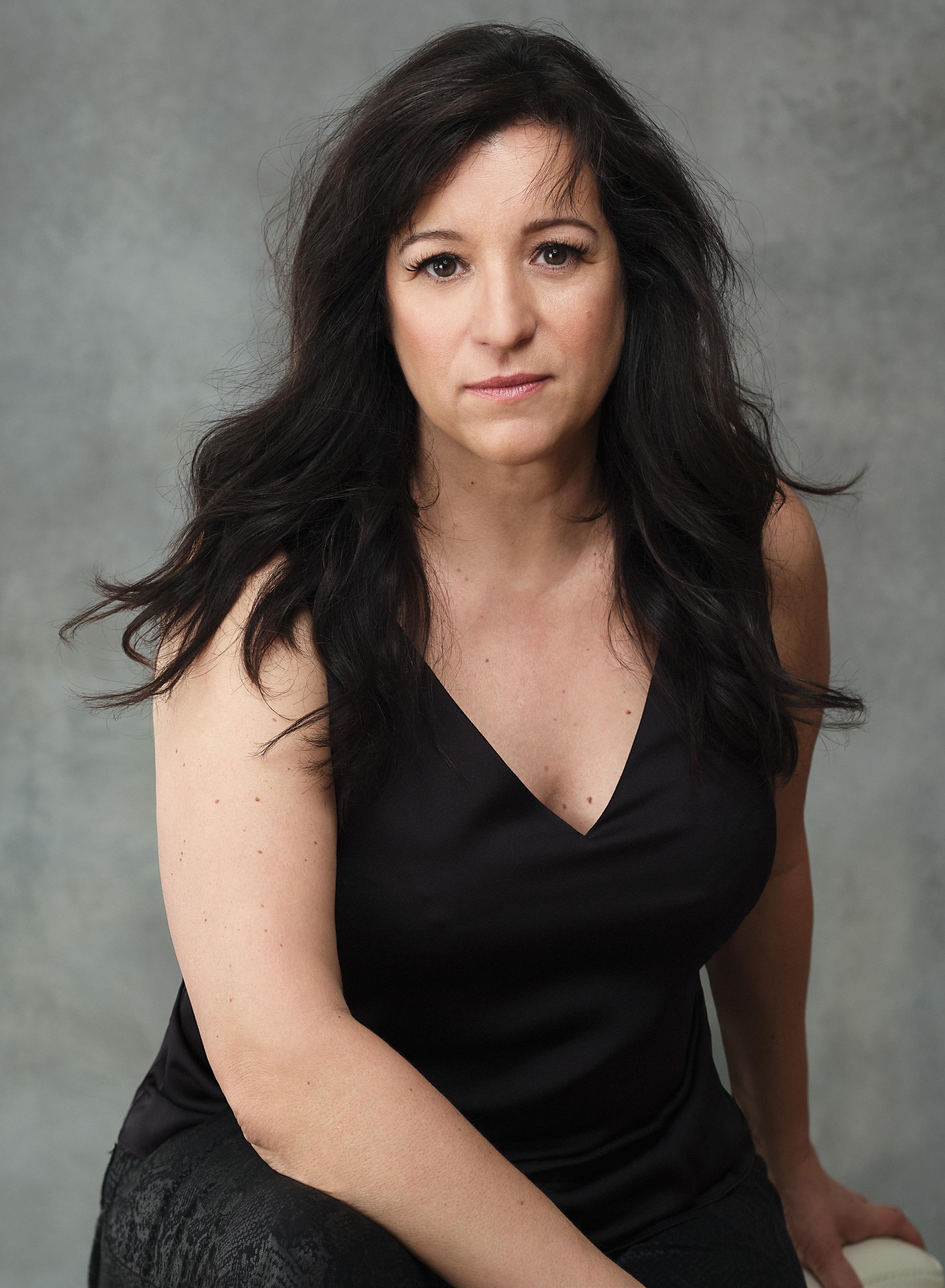
focusPulling
By Meredith M ac Leod | se L f-portraits B y M arta hewson for hc M sty L
MAY/JUNE 2023 HCM 21
ed B y: kate L yn o’nei L | photo assistant: jerro L d hewson
Two abductions have been turning points in photographer Marta Hewson’s life.
The first came in 1974 when she was just four years old. Her father, president of a successful family construction company, was kidnapped during a socialist uprising in her native Portugal.
Thanks to the help of his brother, her father managed to escape. Though Hewson was too young to remember, her parents packed their seven children into a van that crossed the border to safety in Spain in the middle of the night.
The family immediately came to Canada as refugees and settled in Montreal.
If it’s possible, the second abduction may be more surprising.
Hewson was a first-year photography student at Sheridan College. She kept crossing paths at parties with this tall, lanky
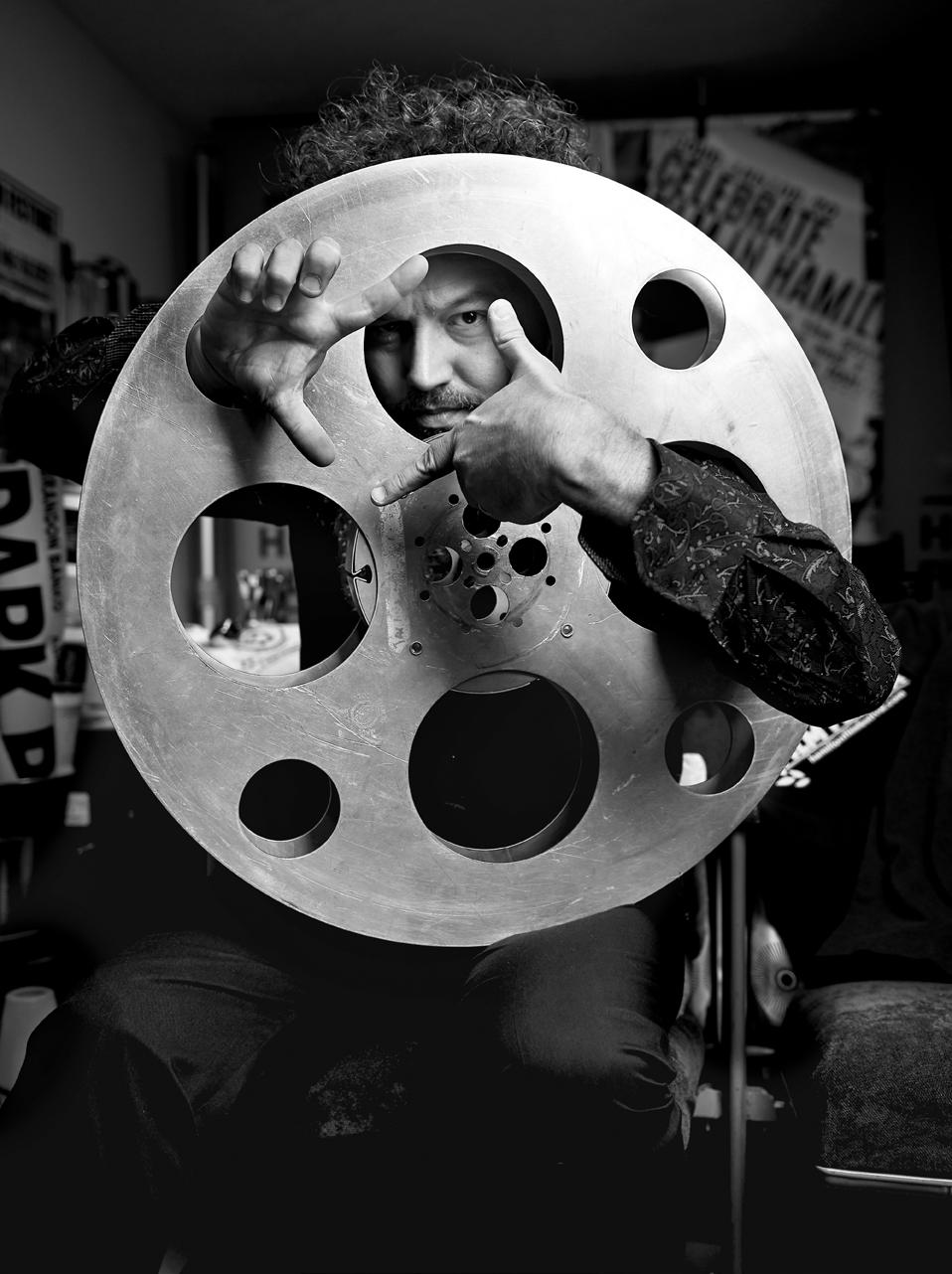
guy with a sense of humour who was in the college’s animation program. They managed to only share a few words but clearly noticed one another.
One day, Hewson decided she was tired of waiting for circumstances to bring them together. She wrote a ransom note, showed up at his place with a friend and left the note for his roommates, who were playing video games and mostly indifferent to the whole thing.

Complete with blindfold and rope for his hands, she bundled Jerrold Hewson into the back of the car.
“He did not resist at all,” laughs Marta. After a trip to McDonald’s for ice cream (doesn’t everyone go for ice cream after abducting their future husband?), their fates were set.
They moved in together less than a month later and were married a year later in 1994.
“I had to be persistent and take the lead. I can tell you we wouldn’t be together today otherwise,” says Marta.
Jerrold fully agrees and is just fine with that. He grew up in Windsor and he and his two sisters were raised by a strong-willed single mother.
“My mother was very adamant about a lack of gender roles. There were no male or female chores in the household and she didn’t go for words like fisherman or manpower. She was a woman ahead of her time,” he says.
So now, Jerrold works alongside Marta in their large and airy photo studio on the second floor of the Dye Works building at the Cotton Factory. Marta launched her own business out of her living room in 2000, while she was pregnant with their second son.

Christopher Robin was born in 1999 and Jack Frost was born a year later.
Up until then, Marta was an assistant to Toronto photographers, including Chris Nicholls, one of Canada’s top fashion photographers. She lugged gear, set up lights, delivered food and coffee, and couriered film to the lab.
22 HCM MAY/JUNE 2023
Jerrold worked as a server and manager in restaurants, while often holding down the fort at home. But he frequently worked nights and weekends and missed out on family time and gatherings.
So about eight years ago, when Marta’s business grew to the point that she needed someone to help, the couple decided Jerrold should give up his two jobs and become a studio partner.

“We are best friends,” says Jerrold. “We are always together. We like it that way.”
Both Marta and Jerrold are artistic types, who thrive on being creative.
“This is a fun job. It’s challenging and exciting but it’s not stressful,” she says.
It’s also not stayed in one place.
Her business was initially centred around weddings, portraits and some commercial work.
But when she realized she wasn’t enjoying the wedding grind anymore, she decided to give it up, even though it accounted for 70 per cent of her income.
“I’ve always been a risk-taker. I do what feels right and I know I can figure out how to make it work. I want to do what I love to do.”
And what she loves is bringing a high-
fashion sensibility to the portraits of ordinary people.

“We focus on giving clients the best experience they could have here. We make it all about them. I don’t care someone’s age or size; anyone can have a fashion model experience who wants to be photographed.”
Whereas some photographers want to shoot in volume, Marta chooses to shoot two or three times a week – whether it’s portraits, boudoir or branding work.
“There is so much involved in this process.”
It starts with a consultation in the studio during which Marta gets to know clients and what they are looking for. She then plans out a shot list, including clothing and looks. Then comes light testing and set up of equipment the day before. The testing involves Jerrold, who stands in for the client. He’s up for anything – wearing wigs and makeup, testing poses, even putting a pillow under his shirt to stand in for a pregnant woman. Sometimes it means squatting so that his sixfoot frame approximates that of a five-foottwo woman.
“I love the planning of these shoots,” says Marta, who has shot each of the covers for HAMILTON CITY Magazine. “Some photographers photograph what exists. My preference is to start from nothing and create an image. Sometimes I have to remind myself to take my camera to family events because that documentary style isn’t my passion.”
The shoot itself takes about four hours and features hair and makeup done by Katelyn O’Neil, along with snacks and champagne. Clients always get multiple “looks” during their shoots.
“I always want to offer a custom experience. It might not be as time efficient but it’s about personalizing it to the client and making them feel like a celebrity. I want them to be thrilled with the entire experience and leave feeling empowered and with a boost of self-confidence.”
The days after the shoot include narrowing down the images to the best ones, sitting with the client to make choices, and touching up images and editing photos for composition, colour quality and contrast.
Clients can order digital files, prints, wall art or books.
“My goal is to help people love the experience of being photographed,” says
MAY/JUNE 2023 HCM 23
continued on next page
I always want to offer a custom exper I ence. It m I ght not be as t I me eff I c I ent but I t’s about personal I z I ng I t to the cl I ent and mak I ng them feel l I ke a celebr I ty. I want them to be thr I lled w I th the ent I re exper I ence and leave feel I ng empowered and w I th a boost of selfconf I dence.”
m arta
h ewson
/
Marta, who is now exploring fine art photography.
That work will be on display in an upcoming exhibition called Outlier at the Cotton Factory. It begins May 4 and will go two to three months.
“The series is about the model’s interaction with an object. The object is an outlier, either due to its size, texture, or purpose.”
Marta and her team are also pursuing passive income from fine art sales, gallery exhibitions and products featuring her photos. She’s also developing a workshop series to help fashion models and aspiring photographers understand the world of fashion photography.
“There isn’t a lot out there for new models. They have to learn on the job. Modelling is about so much more than looking pretty. The job of the model is to make clothes look good and to sell a brand through attitude, expression and performance. But that’s not easy to do.”
So, let’s go back to Marta’s Portuguese roots for a minute. She is the youngest of her large family, coming along seven years after her closest sibling. Her parents stayed in Montreal for four years before going back to their life in Portugal with Marta and two of her brothers. The older siblings stayed in Canada.
Though she spent much of her upbringing in Lisbon, it’s not apparent in her speech.
“Everyone asks why I don’t have an accent,” Marta says with a laugh. “It’s because I went to an American school. Now, almost everyone in Portuguese cities speaks English fluently, but then it wasn’t as common.”
Jerrold good-naturedly jokes that Marta’s family are the Von Trapps of Portugal, referring to the classic tale of a wealthy Austrian family who resist the advance of the Nazis in The Sound of Music.
There might be a couple of similarities, especially the stealing away from an authoritarian regime in the middle of the night. And Marta also admits that her mother
made clothing from curtains for her children. But Marta says she never thought of her family as wealthy. Her dad had grown up poor on a farm but his mother convinced her six sons to take on different trades, including carpentry, metal working, and masonry. Marta’s dad, though, was interested in business. He couldn’t afford university, but he snuck into the classes anyway. He was told that as long as he was quiet, he could stay.
He finished business school and he and his brothers opened a construction company that built schools, museums and hospitals. Marta went to the opera and theatre and hung out at the pool at the golf club where her parents were members. But she was expected to work on the family’s farm, too.

“My family was never materialistic and I’m still not.”
Jerrold’s childhood was much different. His father, who left when Jerrold was four, didn’t pay alimony until his son was in high school. The family relied on social assistance.
After finishing high school and working for a year in her dad’s company, Marta decided to return to Canada, moving in with an older sister who lived in Oakville.
Photography was always her natural path.
“I got my first camera for my birthday at 15. I started taking pictures of my friends. I would look through magazines and try to recreate those photographs. In high school, my art teacher set up a dark room just for me and my friend who was also into photography. I just loved being in the dark room. It’s like magic.”
Now, Marta’s magic is in shining her camera’s lens on her subjects’ inner selves, whether that’s for portraiture, fashion modelling, magazine shoots or branding portraits. In a behind-the-scenes video on her website, Marta says passionate people resonate with her.
“The fashionistas, the rock stars, the rebels and the renegades of art. The ones who never quit dreaming and believing; those that shine brighter in a world of blue are lit by an insatiable desire to live a life worthy of a story.
“My job is photography, but my joy is making art that reflects the personality of the eclectic and the eccentric, the classically sensible and the shining stars that come to my studio.” n
martahewson.com
24 HCM MAY/JUNE 2023
scan the qr code to see more photos and a special behindthe-scenes video with marta
hamiltoncitymagazine.ca
Marta and Jerrold Hewson work side-by-side in H er p H otograp H y studio at t H e Cotton FaC tory. tH ey H ave been toget H er sin C e Marta play F ully kidnapped Jerrold w H ile t H ey were bot H in C ollege 30 years ago.
Roll the Credits
THE CITY HAS BECOME A FILM AND TV POWERHOUSE FOR MANY REASONS AND THAT SHOWS NO SIGN OF CHANGING.
By vanessa green
“You can fake it all in Hamilton.”
That’s according to Zach Zohr. And he would know. He’s been working in the film industry for over 25 years. He heads up Hamilton Film Studios (HFS), a fixture in the city’s film scene that offers studio space, equipment rental and an expendables shop.
In 2018, before Hamilton became the film and TV mecca it is today, and as the boom of streaming services started picking up steam, Zohr saw the writing on the wall. He packed up his life in Etobicoke, moved to Hamilton and set up HFS with two business partners who also relocated to the city.
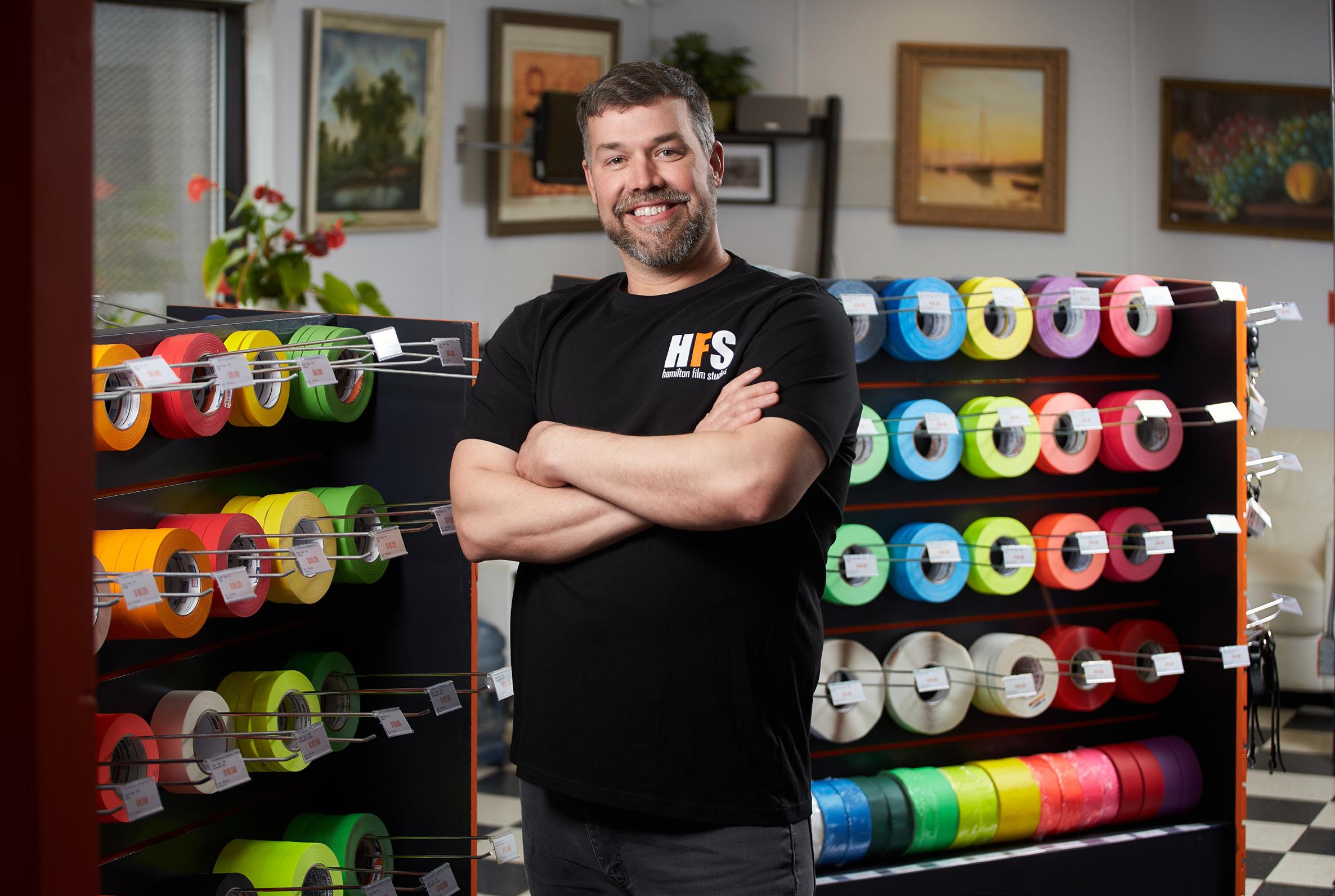
“A lot of people saw what was on the horizon, but we were the first to find the right formula. Four years later, we sweated out the pandemic, and we’re still here and doing quite well, actually.”
The full-service studio has become a trusted one-stop-shop for production teams who need everything from tables, tents, heaters and makeup mirrors to director’s chairs and even a space to film.
But what drew Zohr and hundreds of film and TV productions to our fair city and made it one of the country’s biggest film and television hubs?
Well, our diversity, of course.
Within a 20-minute drive, you can be at a waterfall, an abandoned factory, a stately Victorian manor, a downtown strip that could double for any U.S. metropolis, a conservation area, an outdoor (or indoor) stadium, cobblestoned streets or sprawling farmlands.
On top of that, there’s a huge amount of investment flowing into the city to support the growing film industry. In 2021, Aeon Studio Group’s Bayfront Studios opened the doors to its 27,000-square-foot film studio and production facility, the largest in the city. Located on the Hamilton waterfront, it sits across the street from the Barton Tiffany lands, where the company is planning to build out the rest of the Hamilton Studio District, a live, work and play hub for the creative industry that will feature studios, offices, retail and residential space.
And you can access all of this without competing with bumper-to-bumper Toronto traffic – an absolute must for production crews on tight shooting schedules.
It’s no wonder Hamilton has been called “a location’s scout dream.” It’s provided the background for countless blockbuster films
/continued on next page
MAY/JUNE 2023 HCM 25
Zach Zohr, heads up h amilton Film s tudios, which set up shop in the city in 2018 to take advantage o F the coming boom as a hub o F F ilming. photo: jon evans for hcm
and TV shows, including The Handmaid’s Tale (Hulu), The Boys (Amazon Prime), The Umbrella Academy (Netflix), Guillermo Del Toro’s Shape of Water, Nightmare Alley and Cabinet of Curiosities (Netflix) (Del Toro is a known Hamilton super fan), Murdoch Mysteries (CBC), Locke & Key, Titans, The Queen’s Gambit, Shazam, and the list goes on. New productions shot in the Hammer to keep an eye out for this year include The Big Cigar (Apple TV+), Alex Cross (Amazon Prime), The Invisibles, Eli Roth’s Thanksgiving, and Blackberry
But it’s more than just a variety of location options and a super-sized studio that’s led to the explosive growth of the city’s film scene. It’s also that Hamilton has a big-town feel with a small-town heart. And that means taking a collaborative – rather than competitive –approach to how it serves the industry.
“Aside from (working together) just being good business, (it’s nice to) feel like you’re part of a community. We all back each other,” says Zohr. “If the studio down the road is doing well, that’s only going to overflow to other businesses in Hamilton, like the coffee shops, restaurants, caterers, and hotels. It’s better for everyone, and it all trickles down. It’s just good for the city.”
This sense of community within the film and TV industry extends beyond Hamilton’s borders. Kim Aldavez, senior project manager of the City’s Film Office, says that part of the reason Hamilton has become such a draw for production companies is how the city works collaboratively with other film offices throughout Ontario.
“Every Friday, the Ontario Film Commission leads a town hall with all the busy film offices in the province. They provide industry updates as well as information about production teams scouting throughout Ontario,” says Aldavez. “What’s unique (about Hamilton) is that we share best practices and try new online processes between municipalities. It’s become a bit of a selling point because it means production teams have this smooth experience where they can (easily) move from jurisdiction to jurisdiction. It’s a concierge level of service: if we don’t have it (in Hamilton), we’ll tell you where to get it.”
This streamlining of processes includes handling all permitting for production teams through one central Hamilton office, providing service level agreements to ensure production issues get dealt with quickly, and using vacant land as basecamp parking for
crews and equipment, among other benefits.
“(Film and television businesses in the city) can’t survive just having borders at Hamilton, you need support from across the region,” says Aldavez. “So if we want jobs for businesses in Hamilton, it really does require a regional approach. It’s a ‘rising tide raises all ships’ kind of mentality.”
And this collaborative working style and white-glove level of service has made Hamilton a film and TV pioneer in the province.
“I’m proud that Hamilton has emerged as a leader, and our processes work really well,” says Aldavez. “We get called on a lot by emerging film offices to help them with best practices and putting things in place. So having that recognition is really great.”
These last few years have really seen Hamilton come into its own in terms of establishing the city as a turnkey solution for production crews. But beyond the studio space, rental equipment, and streamlined filming process, the city offers something else to those working in the industry.
“(Hamilton’s) got upmarket, long-term rentals, fantastic amenities that offer a quality of life that helps attract top talent to live and work here on a show for six months
of the year,” says Aldavez. “We’ve also got fantastic food, art, and music scenes. And it’s not all smokestacks – there’s green space everywhere. It’s a great place to raise a family. And then people from the industry move here and set up their businesses here because they want to work where they live.”
The economic impact of the film and TV industry in Hamilton can’t be understated. In 2022, film and TV production companies spent nearly $73 million on 177 productions in the city, with more than 900 film permits being issued. The money earned from these productions is invested back into the city to support municipal programs.
More than 9,000 Hamiltonians work in the film and television industry, and there are more than 900 film-related businesses in the city. These include local favourites like Millworks Creative and Green Door Studios for studio rentals, Picture Perfect Package for lighting, grip and power rentals and Theatrix Costume House for costume rentals and custom-designed costumes.
And, of course, there’s the tax credit. The Ontario Film & Television Tax Credit (OFTTC) offers a 35 per cent refundable tax credit on labour for film and television productions in the province. But there is an additional 10 per

26 HCM MAY/JUNE 2023
Actors Elliot PAg E , c E ntr E , A nd Emmy rAv E r- lA m P m A n during filming of th E third s EA son of the umbrella academy on King Willi A m s tr EE t in hA milton in 2021 photo: Netflix
cent bonus on all labour expenditures outside the GTA. And the first city outside of Toronto where that bonus really kicks in is Hamilton.
On big-budget blockbuster film and television productions, that additional 10 per cent is a huge cost-savings, making Hamilton an even more attractive location to production teams.
But not all the movies and TV shows shot in Hamilton are large-scale productions from streaming giants. The city also supports local, independent artists and young aspiring filmmakers. One of the most ardent champions of Hamilton’s film scene is Nathan Fleet, director of the Hamilton Film Festival and executive director of the Hamilton School of Media Arts.

Fleet helped found the city’s film festival, now in its 18th year, which is rated in the top 100 best-reviewed festivals among more than 10,000 film festivals, according to FilmFreeWay, a leading film festival marketplace.
One of the benefits for aspiring filmmakers when it comes to screening their projects at the city’s film festival is the opportunity to have their work picked up by a distributor.
“We get distributors looking at our festival content,” says Fleet. “Many filmmakers have received distribution deals just from screening at our festival. It’s really hard to
get your movie seen by anyone these days because there’s so much content out there. We try and come up with little additional ways that people can get their work seen, and distribution is one of them.”
The festival also offers youth, student and emerging filmmaker programs to give screen time to new and young filmmakers. Supporting the next generation of Hamilton filmmakers is especially important to Fleet. Last year, he launched the Hamilton School of Media Arts, an education program run through the Hamilton Film Festival inside the Ancaster Memorial Arts Centre.
The programs include a summer camp for kids and teens and programs for adults that cover key areas like directing, cinematography, writing, editing, and acting. But it also exposes students to other jobs in the film industry they may not know about, including script supervising or boom operating.
“There’s been a really big gap in filmmaking education, film and television and new media. Each season, we try to bring in a new skill, whether it’s producing technical programming or computer animation. The goal is to work with other film schools and post-secondary schools (so we can) be that place where students come to develop those skills to build up their portfolio where they can
apply to some of these film schools,” says Fleet.
“I see all these young filmmakers that have all these ideas about what they want to shoot, and they want to do it here in the city. And when they’re ready to do it, they’ll be able to do it because there’ll be the studio space. There’ll be rental facilities. They’ll be the crew, and there’ll be the cast. Everything is here for them.”
Like any industry, the film sector faces its own set of challenges. A looming writers’ strike in the U.S., profitability challenges facing streaming services, and the precariousness of film and TV tax credits are all potential roadblocks for the industry. In 2015, Nova Scotia’s film industry was decimated when the provincial government terminated its long-standing film industry tax credit. Thankfully, “Halifornia”’ is now back up and running.
Fortunately, Hamilton has a welldiversified mix of foreign and domestic productions. While streaming services film here daily, there is also a steady mix of locally produced made-for-TV holiday movies, docudramas, and historical reenactments, that get sold on to other markets and specialty cable services. This demand, according to Aldavez, has held steady for the past 20 years and shows no signs of stopping.
“We’re very well insulated here because it is a little bit of a 50/50 split. So if the Netflixs and Amazons of the world start tightening their belts a little bit, there’s still a lot of work for local people through this domestic production.”
And domestic production continues to be a driving force when it comes to the film industry in Hamilton.
“One of the best things (protecting our film industry) is the support that we are seeing for Canadian filmmakers and Canadian storytellers,” says Aldavez. “There’s a hunger and a desire to hear our own stories, and to hear equity-deserving groups telling their stories and stories that maybe didn’t get as much airtime in the past.”
And as for being Toronto’s “little brother” when it comes to film and TV production, Aldavez says all of that’s about to change.
“(Our reputation) is not just about being down the road from Toronto, you’re gonna see us really come into our own,” she says. “I really think Hamilton is poised to emerge as the film hub of southwestern Ontario in its own right.” n
MAY/JUNE 2023 HCM 27
The Cork Town Pub and i Ts surrounding s T ree Ts are frequen T ly used for lo C aT ion shooTs. i n 2022 , film and TV P rodu CT ion C om Panies s P en T nearly $73 million on 177 P rodu CT ions in h amilTon. photo: supplied
A FEAR OF HEIGHTS
WATERFRONT SAY IT’S TOO TALL.
BILL CURRAN .
The Hancock Tower in Chicago was the world’s first high-rise home built in 1969, with 700 apartments stretching up 100 floors. It remains a highly valued, expensive building.
Hamilton’s own Century 21 apartment tower (now Landmark Place) followed in 1975 at 45 storeys, of which the top five floors were premium offices. It remains our tallest building.
As context, Hamilton’s 150-year stampede of advancement, expansion and unbridled immigrant opportunity collapsed with the steel and manufacturing industries in the mid-1980s, causing societal-wide impacts that remain. Finally, we have a yearned-for return to prosperity after decades of poverty and emptiness, but it is bemoaned by some (negatively) as gentrification, a misstatement if ever there was one.
Fast forward to 2023, and with a glacial implementation of the Setting Sail Plan by City staff and politicians since 2001, we
stand on the precipice of perhaps someday actually building much-anticipated homes to breathe life back into a huge piece of prime waterfront reclaimed from industry.
FYI, the Egyptian pyramids only took 20 years to build, Hausmann’s 19th-century reconstruction of Paris happened in 17 years and the World Trade Centre rebuild also took 17 years. What failed in Hamilton that we have little built yet but an ugly sewage pump station set in the worst spot right on the Pier 7 waterfront? This is yet another sad City leadership story.
After a painfully long process, a highly capable development team was selected in 2017 to redevelop piers 7 and 8 into apartments, a lauded plan was produced and approved. Nothing happens but some infrastructure work paid for by taxpayers. Then, with an approved plan of eight-storey apartment buildings, suddenly a 45-storey tower proposal appears.
Masterplans like this always evolve. As with
every planning proposal, some people are always against change. But our democracy requires that you articulate any planning concerns with facts, not horseshit speculation or feelings, “what ifs” and opinions. Every NIMBY objector formulaically says a development will affect views, cause shadows, have unworkable traffic volumes, have inadequate parking, reduce land values … blah blah blah. Rarely are objections based on facts.
So, let’s explore the tower objections and see what facts support them.
NO TOWER: LET’S UNPACK THE ARGUMENTS AGAINST THE TOWER CONCEPT Process Concerns
A small group of relentlessly vocal and litigious North End residents who oppose and appeal almost every development or City planning change appealed the zoning bylaw for pier 7 and 8, and in a settlement meeting out of the public eye that included just them, the developers and City staff, lobbied

28 HCM MAY/JUNE 2023
OPPONENTS OF A 45-STOREY TOWER ON THE HAMILTON
THE FACT IS, IT’S NOT TALL ENOUGH, ARGUES ARCHITECT
An A rtist’s rendering of the future development of p ier 8 , including A
A
concept for
45 -storey tower. photos: supplied
“on behalf of the community” they claimed to represent for “more family units.” The developers answered that they could meet this odd goal by building a 45-storey tower on a lot previously proposed as a four-storey institutional building.
Why? Some posit that the appellants were duped by the developers. A family unit was defined by the developers as twobedroom or larger, with astute observers noting a one-bedroom-plus-den is the same as a two-bedroom. The reality is that most developments that are not “entry level” are focused on larger, two-bedroom or onebedroom-plus-den units anyway (entry-level buildings focus on one-bedroom and studio units, and are not built on high-value sites like waterfronts).
Will this tower bring families back to the North End (as if they ever left)? Will families really live in a tower? Surely some, but highrise life is not appealing for most families if they have the choice. Oops?
As a second selling point, the developers proposed to build a signature architectural statement that would mark Hamilton’s renaissance. The architect noted that you cannot achieve a signature architectural form in low height, especially since you will have a series of eight-storey buildings around it and several high-rises nearby, including the 17-storey CityHousing Ken Soble tower, 22- and 19-storey Pier Towers on John Street North, along with numerous tall industrial structures and the Copps Pier yellow gantry art installation.
So a 45-storey signature tower (arbitrarily set at the-then City maximum escarpment
height) was quickly agreed to and here we are. Bring on the families back to the North End, and create a Hamilton landmark for good measure!
It does seem very odd that those against a seven-storey building are now pro-45 storeys. This lobbying has gone over poorly with many residents who are adamant that this group does not represent them.
Despite a troubling process, it still needs City approval that is subject to public input, but that does not change the only essential issue: is this a good development based on what constitutes good planning?
The anti-tower opposition leader
Jeff Glen, a long-time North End resident, vehemently objects to this process that sees a few unappointed and contentious citizens trying to make decisions for the neighbourhood and lobbying for a tower. Glen also laughs at the weak argument that a tower will attract families.
The Planning Act does not control who lives where, and the Human Rights Act likely would not allow anyone to control who lives in any apartment, such as if a single person or couple choose to live in a two- or threebedroom apartment. No one is authorized to ensure private property is lived in by four or more persons.
Glen tells me he also does not see how any tower could enhance the waterfront, and considers anything above 12 storeys as wrong and “ominous” looking, but this clearly is an opinion that lacks planning merit.
He worries a tower will change the look and feel of the North End neighbourhood and the
entire city, which seems highly unlikely for one building, especially since the three high-rise apartment buildings a few blocks away have been there for about 50 years and no one has ever claimed they changed the look and feel of the community, much less the entire city of Hamilton. This lacks planning merit.
Other arguments raised against the tower from North Enders include:
■ It will block sight lines of the water and waterfront views: Views of the water will be blocked by even a low building or house depending on where you stand, so this seems a non-starter.
■ A tower will be incompatible with nearby industry: Piers 7-8 will include numerous apartment buildings all closer to industry than the tower, so since they will function fine, this is also a non-starter argument.
■ It will set a precedent for tall buildings that could turn the local waterfront into the “plugged” skylines of Toronto and Burlington: The signed agreement states that all other buildings will remain eight storey maximum. End of story.
■ It will cast shade on the neighbourhood: This is an odd one, as the tower is on the north side of the site, and the sun is in the south, so this seems poorly considered. Regardless, the architects’ carefully considered and very detailed shadow studies (well beyond the norm on any development) clearly show that this is absolutely not at all true.
■ It will bring unwanted traffic to area streets: Again, the agreement is that there is no increase in the approved number of apartments on all of Pier 7-8, so this is not based on facts.

In written comments submitted to public meetings, opponents have said they flat-out don’t want towers on the site, contending the proposed structure is “way too big for the area” and its “small/big town feel.” Others criticized it as “monstrous,” and “a giant eyesore” in the making. But these are opinions or feelings and not legitimate planning arguments.
Opponents have said the building’s proposed 147 metres will be disproportionate to the escarpment’s 90-metre height. They ask: Doesn’t the city still have height limits shaped by our unique geography?
/continued on page 38
MAY/JUNE 2023 HCM 29
The proposed developmen T for p ier 7 and 8 envisions a mixed-use communi T y anchored by a 45-s Torey Tower.
THE STEEL INDUSTRY, PART OF HAMILTON’S LIFEBLOOD, HAS ENDURED 50 YEARS OF TURMOIL, WRITES EUGENE ELLMEN. BUT THINGS ARE TURNING AROUND AS THE WORLD DISCOVERS THE IMPORTANCE OF STEEL IN THE FIGHT AGAINST GLOBAL WARMING.

30 HCM MAY/JUNE 2023
Steel is all around us. It’s in the engines and bodies of the cars and trucks we drive. It’s in the girders and reinforcing bar of the office towers and high-rise apartments we occupy. It’s in the fridges and ovens we use to store and prepare our food.
This material, so omnipresent in our lives, has been a part of Hamilton’s lifeblood for generations. As one of the world’s major steel manufacturing centres, the industry has provided a living for tens of thousands of workers since the early 1900s. It’s no wonder Hamiltonians proudly embrace “Steeltown” and “The Hammer” as nicknames for their blue-collar city.

But the industry has shed thousands of these jobs in the last half-century as it has gone through wrenching technological, managerial and ownership changes to stay competitive with cheaper imports.
At the same time, the public has become more aware of steel’s impact on Earth’s climate. It has become wary of a global industry saddled with outdated and hard-toabate blast furnace technology, responsible for about seven per cent of the world’s carbon dioxide (CO2) emissions.
However, along the way, a remarkable change has happened.
Steel has moved from being part of the problem of climate change to become one of its core solutions. It turns out the fundamental attributes of steel – great strength while also being light weight – are characteristics that can help the auto industry and construction sectors – two key steel markets – slash their CO2 emissions.
Peter Warrian, senior research fellow at the Munk Centre for International Studies at the University of Toronto and a recognized expert on Canadian steel, says there will be especially heavy demand for extra-light steel by the auto industry.
“The new high-quality, very lightweight steel is what you want for electric vehicles,” he says.
This has been shown by Tesla, which has chosen steel rather than aluminum for its mass-market Model 3, Nissan Motor Co, which uses steel for the Leaf, the world’s best-selling all-electric vehicle and Volkswagen, which uses steel for the e-Golf.
This is good news for Hamilton’s major integrated steel companies, ArcelorMittal Dofasco and Stelco, as the North American automakers roll out their mass-market electric vehicles, says Warrian. “They are uniquely positioned because they’re the only producers (in Canada) that do this kind of steel.”
A CENTURY OF STEELMAKING
The Steel Company of Canada (later renamed Stelco) was founded in 1910 from several iron and steel companies. Two years later, a New York businessperson, Clifton Sherman, founded Dominion Steel Castings Company, later to be renamed Dominion Steel Foundry Company, or Dofasco, to make steel for Canada’s growing rail and mining companies. Both companies grew during the two world wars and thrived in the post-war boom of the 1950s and 1960s. In 1954, Dofasco introduced a major innovation in the steel industry, becoming the first company in North America to use the basic oxygen furnace to convert liquid iron to steel. It later adopted continuous casting, which reduces costs by producing large volumes of steel in much less time. Though far lower than peak employment of a bygone era, steel production remains a major player in the city. Primary metal production provides 6,390 jobs in Hamilton, while fabricated metal product manufacturing employs 2,931, according to an economic profile produced in April by the City’s economic development department. Put another way, these two sectors combined have a location quotient of 2.72, meaning that steel production is almost three times as concentrated in Hamilton as it is in Ontario. /continued on next page
MAY/JUNE 2023 HCM 31
photo: mike kukucska
Primary metal production accounted for an estimated $8.94 billion in sales in 2022, while fabricated metal product manufacturing achieved $1.79 billion in sales.
Other major companies within Hamilton’s steel ecosystem include: National Steel Car, founded in 1912 and now the largest producer of railway rolling stock in Canada, manufacturing thousands of rail cars each year; Janco Steel, a major flat-rolled steel service centre; Taylor Steel, specializing in hot and cold-rolled steel products; and Walters Group, a structural steel and construction management company. All are major companies to this day, serving customers in Canada and the U.S.
For ArcelorMittal Dofasco and Stelco, things began to change as cheaper steel imports flooded in from European producers in the 1970s, and then China in the early 2000s. This forced both companies to introduce productivity improvements, outsourcing and layoffs to reduce their costs and stay competitive.
Dofasco went from a peak of about 12,000 workers in the 1970s to about 5,000 today. Even at that reduced level, the company remains Hamilton’s largest private-sector employer.
Stelco’s employment dropped even further. From a peak of about 26,000 workers in 1981 when the company opened its Lake Erie Nanticoke complex, the company now employs about 2,200 workers, mostly in Nanticoke, with the remainder at its continuing coke-making and steel finishing operations in Hamilton.
Stelco filed for bankruptcy in 2004 and was sold to US Steel Company. In 2013, US Steel closed the company’s blast furnace, steelmaking shop and casters at the Hamilton waterfront. “It means we’re not going to make steel in Hamilton,” said Rolf Gerstenberger, head of United Steelworkers Local 1005 at the time, voicing his members’ disappointment. “We’re just going to roll it.”
In 2017, US Steel sold the company to Bedrock Industries, a U.S. venture capital company. Stelco’s new CEO, Alan Kestenbaum, one of Bedrock’s owners, has brought the company back from the brink. The company invested over $100 million to upgrade its Lake Erie blast furnace and other Nanticoke assets during the pandemic slowdown in 2020 to reduce costs and increase output. With the post-pandemic bounce back in steel prices, the company has become a darling
of Bay Street. Kestenbaum has rewarded its investors with buybacks of their shares at premiums to the market price.
For Dofasco, the company found itself in the middle of a bidding war in 2007 between two giant European steel companies, ThyssenKrupp AG of Germany and Arcelor SA of Luxembourg. Arcelor outbid its competitor and took control of Dofasco. Shortly after, Arcelor itself was taken over by the Mittal group of India and Dofasco’s name was changed to ArcelorMittal Dofasco.
The company is now one of the key North American assets in the ArcelorMittal conglomerate, the second-largest steel company in the world.
A GAME-CHANGER EMERGES
Both companies have concentrated on production from blast furnaces.
Blast furnaces are massive iron-making cauldrons heated to over 1,600 degrees Fahrenheit. They are fed with iron ore and coke (coal baked in special ovens to remove impurities), creating pure liquid iron, and in the process, releasing vast quantities of carbon dioxide, the primary greenhouse gas responsible for global warming. The iron is then converted to steel in electric arc or basic oxygen furnaces then cast into slabs before being rolled and finished.
According to the Toronto Atmospheric Fund, Hamilton emitted 10.2 million tonnes of CO2 in 2021, about 20 per cent of all emissions in the Greater Toronto and Hamilton Area. More than 50 per cent of those were from industry, and the lion’s share of those were from the steel industry.
A game-changing technology – direct reduced iron or DRI -- has emerged to create iron using a natural gas furnace, which dramatically reduces CO2 emissions per tonne of iron produced.
ArcelorMittal Dofasco is planning to change the way it makes steel through a nearly $2-billion investment, which includes $400
million from the federal government and $500 from the province, to decommission its existing blast furnaces, coke ovens and basic oxygen furnace and replace them with a massive DRI furnace and additional electric arc furnace technology.
The project will enable the company to cut its annual greenhouse gas emissions by three million tonnes a year, or 60 per cent, by 2028, while maintaining continuous production.
“This will have the equivalent impact of planting 138 million trees or taking 750,000 internal combustion cars off the road,” ArcelorMittal Dofasco CEO Ron Bedard said in an email statement for this article. “And it will significantly kickstart our target to be net zero by 2050.”
Warrian calls this a transformational change in how steel will be made.
“This one’s unique because it’s a radical innovation at the core production technology,” he says. “That’s different from putting a few more robots on your assembly line.”
Talking about the initiative in the House of Commons in March during a visit by U.S. President Joe Biden, Prime Minister Justin Trudeau introduced ArcelorMittal Dofasco employee Neal Pyke who, along with fellow employee Eva Dillon, attended the ceremony in honour of Biden’s visit. Pyke’s mother worked at Dofasco in the 1970s and his father worked in the finishing steel area for 37 years.
“Clean steel will be the backbone for manufacturing in the future,” Trudeau said. “Generations past to generations future will continue to be at the heart of the economy we’re building for the middle class.”
For Bedard, the event was a highlight of his 35-year career in the steel industry.
“The Prime Minister’s point was that an organization like ours is not only important to Neal and all our colleagues working here today, but to Neal’s kids and grandkids as well.”
In addition to reducing climate emissions, the DRI technology will solve the long-
32 HCM MAY/JUNE 2023
Clean steel will be the ba C kbone for manufa C turing in the future. g enerations past to generations future will C ontinue to be at the heart of the e C onomy we’re building for the middle C lass.” p rime m inister Justin t rudeau
standing problem of emissions of benzene and benzo[a]pyrene, two cancer-causing agents emitted by the company’s coke ovens. Health officials and city councillors say it’s time for the company to clean up these emissions. The new technology will virtually eliminate emissions of benzene and other negative environmental compounds.
SO WHAT’S AHEAD?
At Stelco, the future is not clear.
The company is preparing a decarbonization proposal under the federal government’s Strategic Innovation Fund. Details are not known, and no funding has been announced, but Kestenbaum, the Stelco CEO, has spoken enthusiastically about the program in calls with investors and analysts.
As well, last year Stelco sold its 800-acre Hamilton waterfront property to Slate Asset Management, which plans to establish a world-class industrial park on the site. Stelco said it intends to keep leasing some of the property to continue operating its coke ovens and finishing mill.

In the meantime, the company has invested heavily in its Lake Erie blast furnace operations, which would suggest it’s not planning a transformational change. But Stelco is not speaking openly about its plans. This is in contrast with ArcelorMittal Dofasco, which is applying for certification under the Responsible Steel standard, a widely recognized international green steel benchmark. Certifiers have audited the
company on climate change and greenhouse gas emissions, water pollution, biodiversity issues, human rights, labour relations and business integrity, among other criteria.
Bedard also points to the company’s own XCarb recycled and renewably produced label for steel produced from 70 to 90 per cent scrap at the company’s electric arc furnace that avoids most of the blast furnace emissions in conventional steelmaking. The steel has been independently verified with a life-cycle analysis for full CO2 emissions, “an assurance no other steel supplier in North America currently offers,” he says.
The company’s DRI technology also opens the possibility of not just reducing CO2 emissions by 60 per cent, but potentially eliminating almost all emissions. The DRI furnace will be built to be “hydrogen-ready,” meaning it can use hydrogen to supplement or replace natural gas as the iron-making agent. Because hydrogen contains no carbon, the only by-product would be clean water. The company is replacing blast furnaces with similar technology at its plants in Belgium, France and Spain with plans to move them to hydrogen.
But it only makes sense to use hydrogen for steelmaking if the hydrogen itself is produced cleanly with no emissions. This can be done with water, but it takes enormous quantities of electric power to make hydrogen from water.
No one is sure whether Ontario will have enough power by the early 2030s for
ArcelorMittal Dofasco to secure sufficient hydrogen to switch partly or completely from natural gas. This is particularly true as electric vehicles, home heat pumps and other industries like battery manufacturing use up Ontario’s available electric capacity.
Staff at the City of Hamilton are in discussions with a group called the Transition Accelerator about the potential of creating a Hamilton Region Decarbonization Hub, which could explore local clean energy and hydrogen options.
There is still a long path to travel, but Warrian is optimistic that the Canadian steel industry can rise to the challenge of climate change. Back in the 1950s, the industry introduced world-scale innovations in basic oxygen steelmaking and, much later, came continuous casting. He’s confident it can also compete in a world constrained by global warming.
“It’s a terribly interesting time and we have a history of actually getting innovation done. It doesn’t always land where you think it’s going to land. But it happens. So that’s great.” n
Eugene
MAY/JUNE 2023 HCM 33
Ellmen writes on sustainable business and finance. He lives in Hamilton. scan the qr code to read about h amilton success story Walters Group.
hamiltoncitymaG azine.ca
Slate aSS et Manage M ent bought 800 acre S of indu S trial waterfront land and building S fro M Stelco in 2022 i t ha S plan S to redevelop the S ite into a world-cla SS indu S trial park and relea S ed thi S arti S t’ S rendering in May 2022 . Slate agreed to a lea S eback of 75 acre S of land and 2 M illion S quare feet of building S for 35 year S to Stelco.
COMING HOME
HOW INDWELL WENT FROM OPERATING A SINGLE GROUP HOME ON LOCKE STREET TO BUILDING AFFORDABLE HOUSING ACROSS SOUTHERN ONTARIO.
 By Natha N Whitlock | portrait B y jo N eva N s for hcm
By Natha N Whitlock | portrait B y jo N eva N s for hcm
34 HCM MAY/JUNE 2023
It’s not often that people cheer the destruction of a local landmark. And yet, when workers began ripping apart the windowless – and derelict – Ottawa Street North bunker that was the former site of the C.D. Bar Club, the general response in the neighbourhood was relief, even joy. The aptly named bar was a magnet for trouble and crime, culminating in a handful of high-profile stabbings and shootings that forced its closure in 2008. The building then sat empty for nearly a decade and a half, even as the neighbourhood around it came alive with the arrival of new businesses like The Cannon coffee shop, Murray’s Farm Butcher Shoppe and HAMBRGR.
What makes the gutting of the C.D. Bar Club even better is what is being built in its place: not expensive condos or a mega-sized pharmacy outlet, but a new four-storey building that combines ground-floor commercial space with 32 specially designed affordable housing units. A further 12 affordable units are being built in the building next door, which was once a hotel but has sat vacant and has recently been razed. “We’re in the middle of a housing crisis, and this is actually the first good news we’ve heard in a while,” says Tim Hannah, co-owner of The City & The City Books, which sits kitty-corner from the planned Ottawa Street buildings. “What people forget is that interesting small businesses and restaurants are great, but that’s not what makes a neighbourhood. What makes a neighbourhood is people.”
The organization behind this transformation is Indwell, an ambitious and ever-growing Christian charity that, for more than two decades, has been creating housing opportunities for people in need in Hamilton and in a handful of other southern Ontario communities.
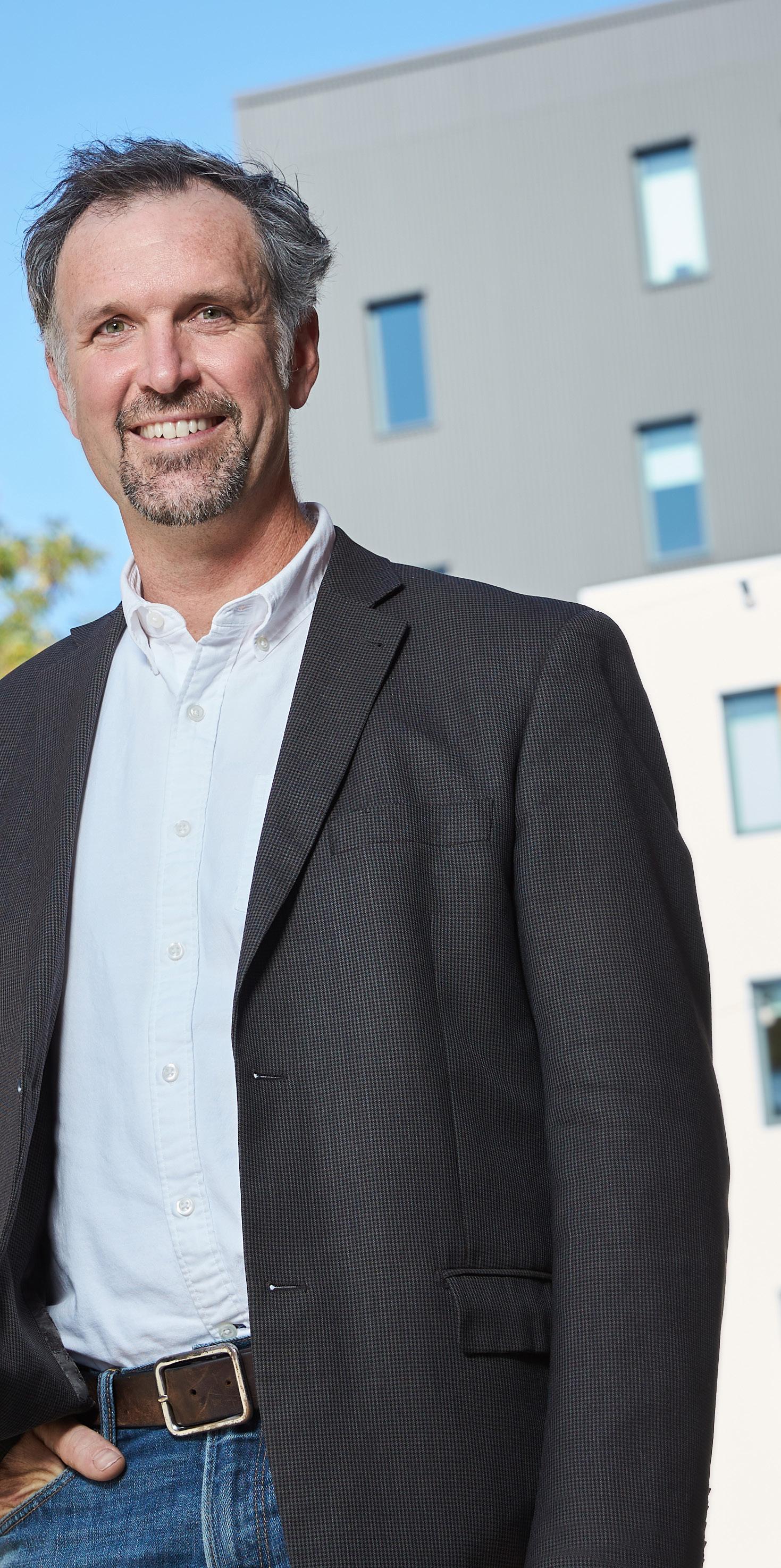
Indwell began life in the mid-1970s as a grassroots response to the then-provincial government’s “deinstitutionalization” policy, which saw the number of beds in psychiatric hospitals cut by more than half. Community-based funding and resources were slow to appear, resulting in a steep rise in homelessness. A small group of like-minded churchgoers in Hamilton began taking people in need into their own homes. Later, they developed and ran a group home called The Homestead, located on Locke Street South, near Aberdeen Avenue.
/continued on next page
MAY/JUNE 2023 HCM 35
Graham Cubitt, dire C tor of proje C ts and development, has been with i ndwell sin C e 2004
The Homestead project, plagued by annual deficits, nearly collapsed by the end of the 1990s. A generous donation from Bill Voortman, co-founder of Voortman Cookies, allowed it to transform itself into Indwell, broaden its mission, and scale up. In 2000, Indwell bought its first apartment building, a six-storey structure on Caroline North. The organization now owns and oversees 19 buildings — 10 of those in Hamilton. A further 11 projects are either in pre-planning mode or already under construction. There are Indwell buildings in Waterloo, London, Mississauga, and elsewhere. The largest is The Oaks, built within a former dairy on East Avenue North, which contains 108 units in its three main structures, with a further 31 units expected to be added in 2023. The smallest is the Railway City Lofts in St. Thomas, south of London, which contains 15 units. Overall, Indwell has more than 1,100 tenants, all of whom would otherwise find it nearly impossible to find safe, affordable accommodations.
Graham Cubitt, Indwell’s director of projects and development, insists that, despite its massive and continuing expansion, the charity’s core outlook has not changed much. “It’s the same organization,” Cubitt says, “with the same vision of how do we prevent and end homelessness by supporting people to maximize their independence despite life’s challenges.”
Indwell wears its religious dimension on its sleeve. The organization’s website notes that “Christians use the word ‘indwell’ to reference the change they observe in themselves when the Holy Spirit lives in them, and they become more like Jesus in their actions, desires, and their consideration for others.” Despite that specifically Christian focus, the site also notes that “our supports, services, and employment are open to people from every creed, race, ethnicity, sex, ability, sexual orientation, and gender identity.”
Cubitt has been at Indwell for most of its history, becoming a director in 2004, a few years after graduating from Redeemer University, a religious post-secondary school in Ancaster. He sees Indwell’s transition from running a single modest group home to owning dozens of buildings as a matter of necessity. “Our history had brought us to a place where we knew how to run good supportive housing but we needed more housing to be built,” he says. “We were doing all this advocacy, but somebody’s got to actually build it,
so we figured out how to become developers. How to find land, how to go through a design process, how to invent new program models and launch them.” Indwell’s growth and success recently led it to create a separate not-for-profit company called Flourish, to act as a kind of consultant for other agencies or municipalities looking to build affordable housing. (Cubitt is also Flourish’s president.)
Cubitt points to the creation, in 2011, of the Perkins Centre on Main Street East as a turning point for Indwell – not only in terms of what the organization could accomplish, but how that project changed public perception of its work. The building used to house a nightclub on the ground floor, with a few dozen dive-style rooms above. It wasn’t just beer and dancing: gun-trafficking was a fairly common activity at the location. “The cops said anytime the bar was open there were five or six officers needed here,” Cubitt says. “Just a real classy place.” After purchasing it through power of sale, Indwell gutted the existing structure in order to create a project with 46 affordable units. The space that once housed the nightclub is now a community centre, complete with a communal kitchen and multiple gathering areas.
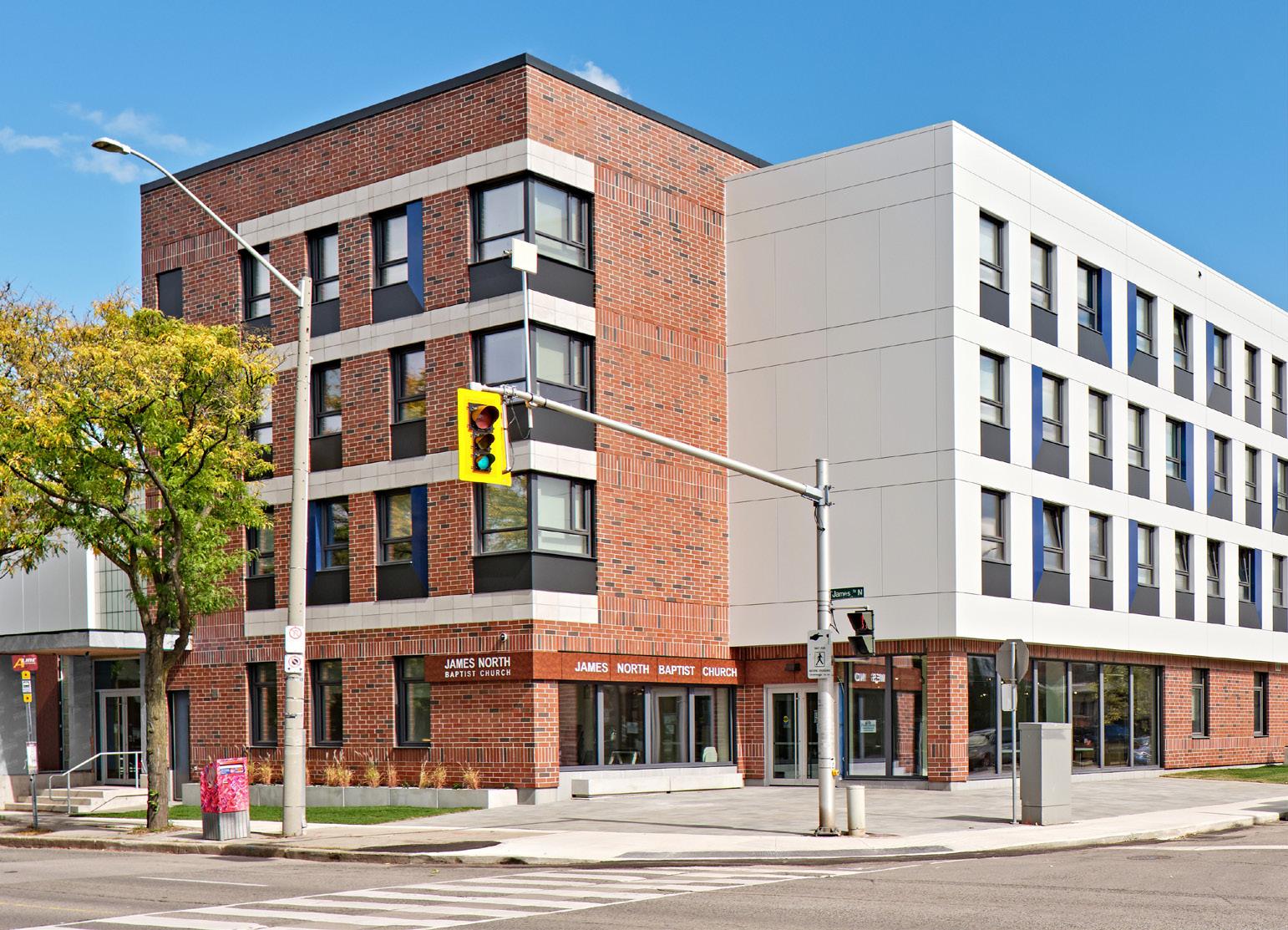
The Perkins Centre was a kind of proof of concept for the organization. “It redefined Indwell,” Cubitt says. “We weren’t just a group
home operator. We could do something about homelessness. We could do something about urban renewal. We could do something about creating beautiful spaces.”
Most Indwell apartments are on the smallish side (the average unit size is between 300 and 400 square feet), but are built with large windows and good-quality materials. Tenants have a lot of flexibility in terms of layout. Often it’s the small details that make a difference. Cubitt notes that tenants frequently note the quality of the washrooms in the units. “Over and over, people talk about how they’ve never had a safe washroom, one that worked right,” he says.
One Indwell tenant, who wishes to remain anonymous, says that moving with her young family into affordable housing, after years of dealing with slumlords and aggressive neighbours, was deeply emotional. “The first week,” she says, “I cried, because I finally felt at peace. We didn’t realize the amount of stress we all carried until it was no longer there. Indwell provided not just a house, but a home; a place we can truly find rest.”
Affordable housing often inspires visions of Soviet-style building blocks filled with desperate people who are mostly ignored by absentee landlords. Buildings overseen by the Toronto Community Housing Corporation, for example, regularly pop up in media stories
36 HCM MAY/JUNE 2023
North E N d La N di N g, a 45 -u N it affordab LE housi N g d E v ELopm EN t at 15 p icto N s t. E. i N h ami Lto N , op ENE d i N th E summ E r of 2020 photo: Industryous p hotography
ANSWERING A NEED
Some of Indwell’s most recent Hamilton projects.
THE OAKS
225 East Ave. N.
• Opened in 2022
• 139 units in four buildings
• Built on the site of the former Royal Oak Dairy
McQUESTON LOFTS
256 Parkdale Ave. N.
• Opened in 2020
• 50 units, with 10 reserved for Indigenous peoples
• Contains a new Hamilton Public Library branch (Parkdale)
NORTH END LANDING
15 Picton St. E.
• Opened in 2020, through a partnership between Indwell and James North Baptist Church

• 45 units
• The building won Sustainable Architecture & Building Magazine’s 2022 Mixed Use Award
about crumbling infrastructure and, more than a little ironically, score poorly on that city’s own apartment evaluation program.
Cubitt is proud of the fact that Indwell’s buildings are not merely functional, but in most cases, score high in terms of aesthetics. He points to the Rudy Hulst Commons building, directly across from the Perkins Centre, which houses Indwell’s head offices on the lower levels, plus 47 affordable units on the floors above. If you’re driving east on Main, the building is hard to miss; the striking structure has a vaguely Minecraft-ian blackand-white pattern running up and down its exterior walls. Beyond that, new Indwell projects are built according to rigorous Passive House standards of energy efficiency.
Creating spaces that look good and are well-managed helps get neighbourhood buyin. Cubitt says he does see some complaints when a new project is announced, but that any NIMBYism is outweighed by welcoming comments. It helps that so many of the buildings Indwell takes over tend to be dangerously neglected eyesores. At one Indwell location, Cubitt notes, a local resident made a point of thanking Indwell for shoveling the sidewalks – a task that hadn’t been completed for decades.
Indwell’s ambition still falls far short of the need, however: roughly 6,000 people are on the City’s wait lists for affordable housing. Tommy Taylor, the manager of community health programs at Hamilton Urban Core Community Health Centre says the issue of housing goes beyond simply ending homelessness – as if that were simple in itself.
“Housing is health care,” Taylor says. “Without appropriate housing, with people living in substandard conditions, that puts excessive pressure on our already fragile health care system.” Taylor applauds the work done by Indwell, noting the impact it has on a political level. “The province, the feds, and the City have the tools at their fingertips to rectify this situation,” he says. “That’s certainly where an organization like Indwell comes into play. Certainly all the initiative and impetus has to come from the staff at Indwell; it’s not coming from the bureaucrats and politicians.”
Operating buildings in which many of the tenants are struggling with mental health and addictions issues creates unique and difficult challenges, and Indwell has recently faced both tragedy and controversy. According to a report in The Hamilton Spectator, police have been called to the organization’s Parkdale Landing project nearly once a day since it opened in 2018. That location was the site of a high-profile murder in its first year of operation, in which a resident was killed by a friend he allowed to stay with him. In 2022, a 45-year-old resident who had been diagnosed with schizophrenia allowed a teen to lie dead in his apartment for a week before his body was discovered. An internal investigation at Indwell following the latter incident recommended a handful of changes, mostly around communication and the frequency with which “check-ins” are completed.
Cubitt admits that these tragedies have led to some difficult learning and changes at Indwell. One major change was to hire a group of nurses for a Short Term Assistance Response Team (or START) who can respond more quickly when tenants are in crisis. He is adamant, however, that Indwell’s core mission has not changed, nor has its ambition.
“We’re not going to stop trying to build supportive housing for people who are in desperate need,” Cubitt says. “Because if we don’t try to build something, and nobody else is able to, what are we going to do as a society?” n
MAY/JUNE 2023 HCM 37
Crowds took in the grand opening of t he oaks C omplex on the former site of the r oyal oaks d airy on e ast avenue n orth in s eptember 2022 at 108 units and another 31 slated for 2023 , it is i ndwell’s largest development to date.
HAMILTON IS HOME TO DENNINGER’S
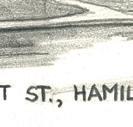
OUR BEST KEPT SECRET! FOR NEARLY 70 YEARS, DENNINGER’S HAS BEEN PRODUCING THEIR OWN SAUSAGES, SPECIALTY COLD CUTS AND SMOKED MEATS IN THE NORTH END OF HAMILTON, DELIVERED FRESH DAILY TO ALL OUR STORES.

Make Denninger’s your destination this summer!
As noted, the height was intentionally set to the City’s arbitrary maximum of the escarpment height (a rule specifically slapped down by the province as lacking planning merit). So today there is no height limit anywhere in Hamilton, and any would have to be proposed based on planning merit. There are no established architectural, planning or urban design rules on how tall buildings should be, only guidelines on how to make towers fit in well to a neighbourhood.
Despite plans to include forward-thinking green technologies and both affordable and multi-family housing in the tower, many of the comments shared during the March 8 public presentation reflect a strong core of NIMBYism resisting the project. That is expected in virtually every contentious planning application, which is specifically why the province updated planning law with Bill 23 in October to reduce irrelevant, emotional or anti-change-based NIMBY objections. Local architects (yes, including me) objected to the City’s arbitrary 45-storey rule and were ignored.
The Ontario Land Tribunal approves 97 per cent of all projects, on the basis of conformance with provincial policy and good planning rule compliance, so solid arguments are needed.
PROS: WHY ALLOW A WATERFRONT TOWER?
If approved, the Pier 7 tower would become the tallest in Hamilton. Is that a good thing?
The development’s lead architect is Hamilton-raised Bruce Kuwabara. From a modest childhood in the North End blocks from the piers, Kuwabara is the most important Canadian architect of our generation, full stop. His past local work includes the renovation of the Hamilton Art Gallery and the lovely James Stewart Centre for Mathematics at McMaster University. His firm’s work across Canada and the U.S. has received numerous Governor General Awards for architecture, he is a member of the Order of Canada and has earned innumerable other architectural and personal distinctions and awards. Oddly, he has never built a new building in Hamilton, and remains very keen to do so. There can be no better architect for this entire Pier 7-8 project, frankly.
something you could look to.” Preferring a simple, sculpted round form clad in coppercoloured metal as the most elegant solution, he has support in the logic of it as minimizing adverse wind impacts.
The Developers Say

The developers argue that the tower allows for more family-sized units while keeping lower density throughout the rest of the pier. The developers are offering 65 affordable housing units, managed by Habitat for Humanity, as a further inducement. The ground-level will have publicly accessible spaces, including a restaurant and will be integrated with a public greenway.
The tower proposal has so far gone through the most design scrutiny ever in the City’s history, by not only City staff, and the City’s tepid independent volunteer Design Review Panel, but also outside urban design consultants hired specifically for the task.
The DRP was absolutely glowing about the design, the urban design consultants’ assessment guidelines seem almost written exactly to dictate the proposed design. The City planning staff report is still underway as of this writing.


A basic fact NIMBYists ignore is the simple market reality that buyers always pay premiums to live on higher floors. People love living high, especially on a visually powerful waterfront. Towers work.
So where do I stand on the tower proposal, as a biased neighbour and architect?

Dear reader, I propose a 65-storey tower. OK, actually maybe higher. Whatever the market forces allow. I really don’t believe we will get a powerful enough landmark at the arbitrary 45-storey height, since the 30-storey larger part of the tower stem leaves only one-third as the slender tower form, a poor ratio in my opinion.
The taller the better; the taller the more impactful as a landmark. Since there is no defensible height limit based on urban design theory, I believe that an excellent design is what we need. Let’s let Bruce Kuwabara work his magic, unfettered to build what he knows is the most appropriate landmark.
FOR LOCATIONS, VISIT WWW.DENNINGERS.COM








As to his motivation, Kuwabara said: “My hope is that through this process [we achieve] something that would be enduring; a marker;
To paraphrase the famous 19th-century architect Daniel Burnham who helped reshape Chicago into the architectural powerhouse it is today: “Make no little plans; they have no magic to stir the soul.”

38 HCM MAY/JUNE 2023
n /continued from page 29
Why not beer?
THE BECAUSE BEER CRAFT BEER FEST HAS BEEN CELEBRATING LOCAL SUDS AND FABULOUS MUSIC SINCE 2014.
Summer is not summer without backyard parties and a lively patio scene, but once mid-July rolls around, it’s often time to explore new frontiers of the social landscape. Ready to combine the alfresco aspect of patio life and the party atmosphere of a backyard shindig with your pals somewhere new? This July, grab your crew and head down to the waterfront’s picturesque Pier 4 Park to indulge in the Because Beer Craft Beer Fest.
Presented by Sonic Unyon – Hamilton’s indie record label –Because Beer is a two-day celebration of the local brews that are rich in character, flavour, and creativity. Now in its 10th year, the festival marks the opportunity for dedicated brewers to descend on the city to showcase their bevvies to new thirsty audiences.
“It has a fantastic vibe – a chance to get together with friends in a big, gorgeous backyard that can pass for cottage country and spend a weekend enjoying great craft beer and cider, delicious food and entertaining bands,” says organizer David Young.
Whether you favour an IPA, a cider, or something hoppy, festival goers are given plenty of chances – 4oz at a time – to learn about the brewing processes, meet the brewers behind the beverages, and sample their way around the event, searching out their favs, all in the name of research.

You had us at beer, but thanks to the organizers’ musical ties, the live entertainment over the two-day fest is always a draw on its own. Past musical performers have included Shakey Graves and Dear Rouge, and Young promises a 2023 lineup of “heavyweight hit machines,” including Born In the Eighties and Dwayne Gretzky.
“Fans of the festival will often buy weekend tickets because we really aim to produce two days of top-notch entertainment that makes the whole experience that much sweeter.” The event promises to be so sweet in fact, that we encourage you to head to the water’s edge, come for the beer, stay for the music, and enjoy the party. The patios will wait. n
MAY/JUNE 2023 HCM 39
The Because Beer c raf T Beer f es T ival in July B rings B rews and B ands To h amilTon’s Pier 4 Park.
IT MAY BE ILLEGAL TO KEEP HENS AND ROOSTERS WITHIN THE CITY LIMITS OF HAMILTON, BUT BACKYARD FOWL ARE A GREAT ADDITION TO URBAN LIFE. By Jason

 a llen
a llen
40 HCM MAY/JUNE 2023
Driving through the tony neighbourhood of Kirkendall South a few years ago, you might have been surprised to see an escape artist chicken nibbling on someone’s priceless peonies, or to look over a fence to see giggling kids bouncing on a trampoline with a few hens, or running them through a chicken obstacle course.
Not your typical urban scene, and indeed it’s technically illegal inside the city limits in Hamilton, but Joanne was not the only person I know who kept chickens.
“Someone has lost a chicken on Napier Street,” announced another friend who had spotted it while riding his bike to work through Strathcona one morning.
The chickens, they are among us.
Why on earth, though, would someone want to keep a noisy, smelly livestock animal in their backyard in a busy urban area?
Indeed, those were the concerns raised when the idea of a backyard chicken pilot came to the City of Hamilton’s planning committee in 2020. Members of the committee voted to reject the idea and not even send it to staff for study, in a move that echoed decisions in 2018 and 2012.
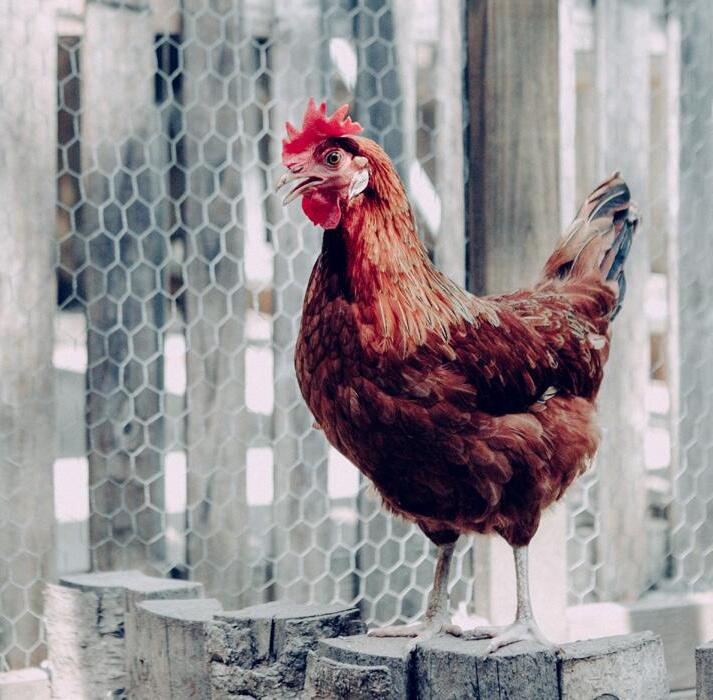
It comes down to the type of animals we allow to live among us, says David WaltnerToews in his book A Conspiracy of Chickens
In an interview about his book on my radio show in December, he talked about how the animals we allow to live with us in a city is a question of what we value. “Sometimes we make a conscious choice, sometimes we inherit a choice. In agriculture, we’ve inherited cattle and pigs and chickens. In cities it tends to be cats and dogs.”
We have made a conscious choice to allow cats and dogs to live among us, so who’s to say we can’t choose chickens as well?
Besides, they’re not that smelly.
“Chicken poop is really dry,” explains Joanne (HCM is withholding her last name).
In the winter, she would keep the whole coop enclosed in a vapour barrier, and in the spring she cleaned out the bedding and mixed it into her garden bed. At the same time, the chickens would scratch for the grubs and insects that lowered yields from her garden.
The waste from the chickens went to feed the vegetables that then fed her family in the summer and fall. From there, the virtuous circle continued with veggie scraps going back to the chickens. “Whatever leftovers that
were vegetarian, we’d just throw them into the chicken coop and the cycle would go on.”
Her chickens, and her backyard, soon became a hub of sorts for her neighbours on all sides. “Some days I’d go outside and there were random children in the yard, just playing with chickens.”
The neighbours also appreciated their morning announcement that it was time to get going. Hens don’t crow the way roosters do, but they cluck when they lay an egg each morning. Joanne’s hens were quite modest, but Waltner-Toews describes one as announcing: “‘I laid an egg I laid an egg.’ She would go on forever.”
Joanne and Waltner-Toews both say their neighbours told them they appreciated the sound in the mornings. One of Joanne’s neighbours grew up on a farm and had pleasant memories attached to the sound, and others were just happy to know it was time to start the day.
Joanne’s experiment in hen-keeping ended suddenly when the raccoons figured out a way to get into her carefully constructed coop. They made off with four the first time, and then two more a couple of weeks later. At that point she threw in the towel.
This still leaves the question, what about eggs? Waltner-Toews describes his egg harvest as “slightly cheaper eggs than the grocery store,” but Joanne found it very inexpensive. Her first coop was a secondhand score from a friend, and a bag of organic chicken feed that lasted three months
or more would only cost $30 or so.
And the reward? An egg per chicken per day for most of the year, except in the dead of winter when most hens stop laying.
If that sounds like a lot of eggs, in Joanne’s house they went to good use. “We eat a lot of eggs. There’s five of us, and my daughter is vegetarian but loves her eggs, and my son … he eats a lot, he’s a football player. Plus you do some baking …”
And, of course, could a few eggs now and then to your neighbours be considered the backyard chicken equivalent of hush money? You see, while chickens are illegal in Hamilton, the bylaw is only enforced on a complaint basis. As with all things, if you know your neighbours, and get along well with them, you might get lucky and evade being reported.
Unless your chickens escape.
“They will escape if you don’t keep an eye on them. They’ll take themselves for a walk and go for a wander,” says Joanne. Likely also the problem with the chicken keeper in Strathcona whose charge my friend rode by on his bike that morning.
Joanne would find them on fences, and would regularly have to go into her neighbours’ yards to recapture her hens.
All of this feathery skullduggery wouldn’t be necessary if we would just legalize them. They’re legal in all sorts of places around us, including Brantford, Niagara Falls, Guelph, Kitchener and Newmarket. The usual complaints about noise and smell are easily disproved. Waltner-Toews – who is a renowned veterinary epidemiologist – has even volunteered to come to a Hamilton city council meeting and provide expert testimony on the benefits and low risk of urban chickens.
His backyard flock in Kitchener was made possible by that city reconsidering its ban, in part due to his delegation to council in 2016.
With the right rules in place, chickens can make a great contribution to food security in our city, and to our quality of life. They can even be, dare I say, cuddly?
“They were lap chickens. They would come and cuddle you,” says Joanne, who raised hers by hand, so they would be used to her and her family and comfortable being handled.
Affection. Pest control. Eggs. Hours of entertainment for the kids. What’s not to love? Hopefully Hamilton will get on the legal urban chicken bandwagon (chicken tractor?) soon. n
MAY/JUNE 2023 HCM 41
They will escape if you don’ T keep an eye on T hem. They’ll T ake T hemselves for a walk and go for a wander,”
Joanne, former chicken owner
Amorning that begins at one of Hamilton’s wonderful coffee shops is a morning done right. Whether you are just looking to fuel up on your own with some java, yearning to chat with a friend over a hot (or cold) drink, or searching for that perfect work spot with a cuppa and a bite to eat – the choices are many in our city. Here are just a few of our favourites.
By Heat H er Peter
TheDailyGrind

MULBERRY COFFEEHOUSE
193 James St. N., Hamilton mulberrycoffeehouse.com
IG: @MulberryCoffee
Mulberry Coffeehouse is one of the Hamilton mainstays in the coffee community and has been around since 2010. Aptly named after the street it’s on – Mulberry and James Street North – the space absolutely stands out with its historic red brick and bold “coffeehouse” sign. The large interior space and great seating options make it a perfect place to meet up with a friend for a cozy cuppa. In addition to its coffee, the Mulberry’s food menu is delightfully extensive, especially for a coffee shop. Options include dishes such as the Mulberry Cubano sandwich, vegan power bowl and lots more. The walls inside are adorned with local artists’ work. Enjoy the great patio in warm weather.
DETOUR CAFÉ
41 King St. W., Dundas
175 John St. S., Hamilton detourcoffee.com
IG: @DetourCoffee
Now with multiple locations in Hamilton – plus Hamilton airport and nearby Paris locations – you have the option of enjoying Detour Café either in Dundas or a new John Street South spot. Each provides a different ambiance, but they serve up the same great product – which they have been doing since 2009. Dundas is the original location and is the most bright and airy
space. At this spot, you’ll find more sit-down food options like avocado toast, Detour breakfast and sandwiches. The John Street South location is more of a cozy coffee shop, offering some pre-made sandwiches and wraps that can be heated. Of course, the coffees they serve are locally-roasted from their own brand – Detour Coffee Roasters. Both locations also offer fresh baked bread daily from partner company Dear Grain Bread.
THE CANNON
180 Ottawa St. N., Hamilton thecannon.coffee
@cannoncoffeeco
The Cannon is often busy with patrons, and with the food and drink offered, you can understand why. Its sunny corner spot at Cannon and Ottawa Street North is an ideal place to spend a bright spring or summer morning. Try an espresso-based drink, or tea latte, along with a savoury or sweet topped waffle. You won’t be disappointed. Join The Cannon’s coffee subscription program, if you prefer staying home to sip your morning brew.
RELAY COFFEE ROASTERS
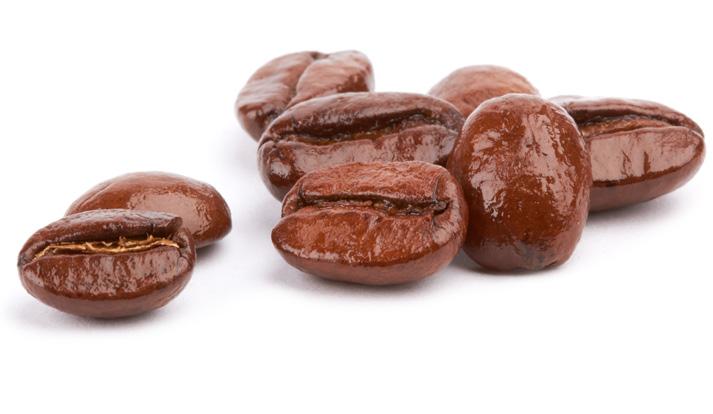

27 King William St., Hamilton
27 Dundurn St. N., Hamilton relaycoffee.com
IG: @relaycoffee
The RELAY team has undergone some changes recently, opening new locations to serve customers better and closing its longstanding kiosk at the Hamilton Farmers’ Market. But no matter where you find them, their spectacular product stays the same – delicious roastedby-them coffee (small batch, organic and fairtrade), Rishi teas and good eats. RELAY gained popularity with its original location on Concession, which opened in 2008, but have since moved to the historic Staircase Theatre and its large location on King William. Be sure to try the baked goods as well.
DEMOCRACY* ON LOCKE
202 Locke St. S., Hamilton democracyonlocke.com
IG: @democracyonlocke
This Locke Street staple stands out from the crowd because the entire menu at Democracy is vegan offerings only. Though with dishes like fries supreme, mac & cheese and Nanaimo bars, you may not realize it. It also proudly calls itself home of Hamilton’s best cauliflower wings. Democracy serves up fair-trade and organic coffee from a local partner company: Coffeecology. It’s also a great place to get some work done during the non-busy hours.
MAY/JUNE 2023 HCM 43
CAFFEINE RUSH
SAINT JAMES
170 James St. N., Hamilton saint-james.ca
COPPER KETTLE CAFÉ
312 Dundas St. E., #4, Waterdown copperkettlecafe.ca
VINTAGE COFFEE ROASTERS
977 King St. E., Hamilton vintagecoffeeroasters.ca
BRING YOUR DOG CAFÉ & PUB

9 Richwill Rd., Hamilton bringyourdogcafe.com
CAFÉ ORANJE
312 King St. E., Hamilton cafeoranje.ca/
OLA BAKERY & PASTRIES
230 James St. N., Hamilton facebook.com/profile. php?id=100054429252320
PAISLEY COFFEEHOUSE & EATERY
1020 King St. W., Hamilton paisleycoffeehouse.com
EMERALD COFFEE
340 Barton St. E., Hamilton emeraldcoffeeco.com
SHADY GROVE LUKAYA CAFÉ
592 Upper Wellington St., Hamilton facebook.com/lukayacafe
CAFÉ DOMESTIIQUE
102 King St. W., Dundas cafedomestiique.com
TAMP COFFEE CO.
2049 Pine St., Burlington 480 Brant St., Burlington tampcoffee.com
SMALLS COFFEE
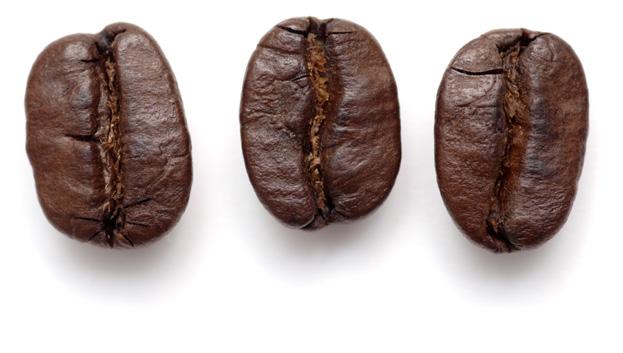
8 Cannon St. E., Hamilton smalls.coffee
PHIN COFFEE BAR
791 King St. W., Hamilton phincoffee.ca
ONE FOR ALL COFFEE & DESSERTS
241 King St. E., Hamilton oneforallcoffee.square.site
MEZZA CAFFE
28 James St. N. Unit 104, Hamilton mezzacaffe.com
STEELTOWN GARAGE
8 Barton St. E., Hamilton steeltowngarage.com
Those wi T h pe T s know T he joy of bringing your furry friend along wi T h you on a day ou T .
Munchies c offee h ouse & b arkery allows for jus T T ha T , all T he while serving up delicious drinks, fabulous food, and a cozy a TM osphere.
MUNCHIES COFFEE HOUSE & BARKERY
1000 Upper Gage Ave., Hamilton munchiesbarkery.com
IG: @munchies.chb
Pet parents know the joy of bringing their furry friends along on a day out. Munchies Coffee House & Barkery allows for just that, all the while serving up delicious drinks, fabulous food, and a cozy atmosphere. Munchies is a dog-friendly café that serves up all the classic espresso-based drinks, plus an extensive menu of creative options: Nutella latte, peanut butter latte, and maple spice mocha – to name a few. In addition to drinks, you will find food options such as from-scratch Belgian waffles, breakfast sandwiches, and a variety of egg bennys.
CANICHE FRENCH BAKERY
346 Wilson St. E., Ancaster canichebakery.com
IG: Canichebakery
Located in the heart of the Old Ancaster Village, you will find a local favourite – Caniche French Bakery. Caniche is housed in a historic home right along the main strip of Wilson Street. Inside, the aroma of robust Balzac’s coffee, freshbaked pastries and breads, and savoury scents linger in the air. Not only does this bakery offer the classic coffee-based drinks, but it also has seasonal lattes. (Be sure to check social media for details) In addition to all the locally-roasted coffee drinks, Caniche also offers high-quality teas from Kusmi Tea. If you’re looking for something on the side, baked goods are done right, from croissants, tarts, galettes and biscuits to quiche, sandwiches and Hamilton Meat Pies. Caniche is more focused on the to-go food and drink options, but there is a small seating area to the back and more seating outside in the summer.
44 HCM MAY/JUNE 2023
541 EATERY & EXCHANGE
541 Barton St. E., Hamilton fivefortyone.ca
IG: @541barton
541 Eatery & Exchange is a café that not only serves up yummy eats and lip-smacking drinks, it also serves its community. Located on Barton Street East, the large 541 Eatery & Exchange is a non-profit eatery that is best known for its button jar. At 541, you can purchase buttons for others that can be redeemed for a meal by community members in need. Dishes on the menu include breakfast sandwiches, French toast, morning glory porridge bowl, spinach salad and much more. With many vegan and gluten-free options, 541 has something for everyone.
SYNONYM
328 James St. N., Hamilton synonymshop.com
IG: @synonymshop
No matter the weather, the bright and airy space of SYNONYM makes it feel as if you’re in the sunniest days of summer. You’ll want to spend time in this café, sipping drinks, eating pastries and chatting with friends. The terrazzo-topped counters are paired with skillfully made espresso drinks and locally sourced dishes such as squash and tahini tartine, smoked trout benny, pumpkin French toast and pork belly hash. SYNONYM also doubles as an independent bookstore and wine bar/bottle shop.
JITTERBUG CAFÉ
35 Main St. N., Waterdown jitterbugcafeandcatering.com
IG: @jitterbugcafe_
Off the main stretch in Waterdown Village, you will find a local favourite – Jitterbug Café. The cozy vibes of Jitterbug Café are matched by the warm service that is provided here. Breakfast meals like bagels, bacon & eggs, omelettes and pancakes are served up alongside lunch items like chicken summer salad, soups and gourmet sandwiches. Try a latte and enjoy the peacefulness this little joint has to offer. Pro tip: Try the salted honey cappuccino.
CHERRY BIRCH GENERAL
219 King St. E., Hamilton cherrybirchgeneral.ca
IG: @cherrybirchgeneral
Cherry Birch General is a café that not only serves up delicious drinks and pastries, but also doubles as a storefront of Canadian-made food products, including candies, hot sauces, spreads, candles, latte mixes, bitters and so much more. Owner Lisa bakes her pastries on-site at this Hamilton International Village location. Try the variety of creative muffins and scones, from peach cobbler and plum almond to cinnamon roll and coconut chocolate. And if you need a gift package, they are always ready to help with warm and friendly customer service.
DURAND COFFEE

142 Charlton Ave. W. Hamilton durandcoffee.ca
IG: @durandcoffee
Durand Coffee may be a true-blue neighbourhood coffee shop, but it has attracted customers from across the city since its opening in 2016. This snug little corner café is a comfortable spot to spend time – whether you’re meeting a friend, doing some computer work, or just celebrating self-care with a book. Though it does offer trendy seasonal drinks, the rest of the coffee menu is just like the space – no-nonsense or frills, just the classics done very well. Durand Coffee also offers courses for those looking to learn more about coffee and the work of a barista.

MAY/JUNE 2023 HCM 45
JOIN US FOR
THE 2023 – 2024
SEASON A CELEBRATION OF THE NEXT 50 YEARS!
FIND YOUR FUNNY
SEP 27 – OCT 14, 2023
JONAS AND BARRY IN THE HOME
WRITTEN BY NORM FOSTER
FIND YOUR DREAMS
OCT 25 – NOV 4, 2023
BOY FALLS FROM THE SKY
WRITTEN AND PERFORMED BY JAKE EPSTEIN DEVELOPED WITH AND DIRECTED BY ROBERT MCQUEEN A TALK IS FREE THEATRE PRODUCTION
FIND YOUR JOY
DEC 6 – 23, 2023
POLLYANNA THE MUSICAL
WORLD PREMIERE
BOOK & LYRICS BY STEVEN GALLAGHER
MUSIC BY LINDA BARNETT
SUBSCRIBE NOW FOR THE BEST SEATS AT THE LOWEST PRICES – WITH FREE AND UNLIMITED EXCHANGES! VISIT THE BOX OFFICE OR CALL 905-522-7529 OR 1-800-465-7529
FIND YOUR PASSION
JAN 10 – 27, 2024
WRITTEN BY ANTON CHEKHOV
ADAPTED BY LIISA REPO-MARTELL DIRECTED BY CHRIS ABRAHAM A CROWS THEATRE PRODUCTION
FIND YOUR SELF
MAR 6 – 23, 2024
SHIRLEY VALENTINE
WRITTEN BY WILLY RUSSELL
FIND YOUR HOME
APR 24 – MAY 11, 2024
UNCLE VANYA BEAUTIFUL SCARS
A NEW MUSICAL CREATED BY TOM WILSON & SHAUN SMYTH
INSPIRED BY THE BOOK BEAUTIFUL SCARS: STEELTOWN SECRETS, MOHAWK SKYWALKERS AND THE ROAD HOME BY TOM WILSON
One for All
AFTER A THREE-YEAR PANDEMIC PAUSE, IT’S YOUR FESTIVAL, ONE OF THE LARGEST CANADA DAY CELEBRATIONS IN ONTARIO, MAKES ITS RETURN TO GAGE PARK THIS YEAR.
Returning to Gage Park after a three-year absence is the venerable It’s Your Festival. Presented by the Hamilton Arts Council, the three-day event held over the Canada Day long weekend is a multi-cultural celebration of our country’s birthday and the multitude of cultures that make it what it is.
After two years of organizing a digital festival, program director Lloyd Turner is thrilled about the return to an inperson event and he’s not alone.
“What we’re hearing from Hamiltonians is actually how excited they are that we are back in person again. Nothing is as good as the feeling of live music and entertainment in a beautiful urban setting like Gage Park.”
Traditionally the largest Canada Day celebration in Ontario over its 54 year run, think of the festival as a celebratory block party kicked up a few notches. Due to its long-awaited return, 2023 is shaping up to be a banner year, with over 150,000 weekend visitors of all ages expected to hit the park to help wish our country a happy 156th.
Like any good community block party, there will be food – the volunteer-run festival boasts a varied selection of foods of the world – as well as live music from a diverse lineup of Canadian artists spread over four stages. Be sure to check out the talents of the musical up-and-comers at the New Music Expo stage before hitting the vendor market and the midway (pro-tip: visit the midway before the food). Staying true to the Hamilton Arts Council’s mandate to nurture and promote multicultural heritage throughout Canada, festival-goers will also enjoy various cultural events during its run, including the parade of cultures, traditional Indigenous performances and perhaps most poignantly, a Canadian citizenship ceremony, where over 50 participants will officially become Canadians.
It’s Your Festival is our festival, because Canada – and Hamilton – is greater than the sum of its parts. We love a great party, especially one celebrating culture, music and community. We’ll see you at Gage Park, so be sure to say hi. We’ll be wearing red. n

MAY/JUNE 2023 HCM 47
It’s Your Fest I val celebrates the cultures that make c anada – and h am I lton – great places to l I ve. photo: Chris Lang L ey

DRAG HAS SASHAYED INTO THE MAINSTREAM WHILE AT THE SAME TIME BEING AT THE TIPPING POINT OF SOCIAL PROTEST. HAMILTON’S DRAG QUEENS JUST KEEP BEING FIERCE.
By ROB PEACE | POR t RA its B y m AR
All Hail the
OR h C m
For the faithful, Easter weekend is a holy celebration of the resurrection of Jesus. Among the more secular, it’s a time to gather with family under bright, early-April morning skies as little ones scurry through backyards in search of their elusive Easter booty. Painted eggs figure prominently, as do bunnies, baskets, and bonnets.
And this year at a downtown Hamilton hotspot, so did drag queens.
“Welcome to our Easter Sunday drag service!” shouts the enormously popular Karma to a sold-out crowd at Moodys Pizza Bar & Arcade.
“Have a good time, people – that’s what we’re here to do. Not only am I your hostess, but I am a nun today and I am your Mother Superior. But you can call me Mama. Give it up for me – Karma Kameleon!”
As the applause roars, she launches into Lady Gaga’s “Judas” without any protests from the crowd. And without any protests outside, either.
Depending on who you ask, a religiousthemed Easter drag event might be blasphemous. Indeed, there are those who would deem any drag show a sacrilege; such has been evident with the slew of nationwide protests as of late. Certainly not anyone in this crowd finds drag obscene, though –
and certainly not Steven Hilliard. His event planning company House of Adam and Steve has organized this event, just one of many drag shows and parties in the Hamilton area that literally fill the social calendar. What started as house parties in his living room with some drag queen friends providing the entertainment soon blossomed into a thriving business that now helps set the stage for Hamilton drag and for queer-friendly spaces in general.
Back in 2015, Hilliard and his thenboyfriend Adam conceived House of Adam and Steve (“With names like ours, how can you not take advantage of it?”) to bring the queer flavour back to the city, which shortly before was home to a solid handful of queerthemed establishments that had all closed. Today, downtown bar The Well is the only dedicated, queer-geared establishment. It’s well-loved among the community and always a good time, but is it enough?

“More queer spaces have to exist, because we need places where we feel like we can be ourselves without persecution and without fear of violence,” Hilliard tells me over a drink at Farside on James North, indeed one of the queer-friendliest areas in town. “So we asked ourselves, ‘How can we make spaces that already exist more queer-friendly and more
/continued on next page
MAY/JUNE 2023 HCM 49
t A h E ws O n f
LEFT: Karma Kam ELE on is a force within the local drag scene.
photos of Karma Kameleon and Kenadie s t. James: marta hewson for hcm photo assistants: katelyn o’neil and jerrold hewson art direction: will vipond tait
queer-safe?’”
They definitely figured it out – and with drag. From a one-off event at the former Baltimore House to wildly successful parties at Absinthe, their business has helped bring drag back to the local masses. House of Adam and Steve organizes drag shows and parties that would make 2015 emerald-green with envy, and stages them at establishments that hadn’t previously thought to host such events. Nowadays, it seems there’s a drag show somewhere in town almost any day of the week.

A regular drag performer and a Hamilton queer-scene darling, Karma is a hugely visible part of Hamilton’s now-vibrant tapestry of queens. As a queer youth in Hamilton trying to find a voice and an identity, Ms. Kameleon fell in love with drama class in high school and then with the idea of self-expression in general. From experimenting with makeup to working up the courage to perform at an open-stage night in Toronto about five years ago, a young Karma-in-waiting fell in love with drag and now considers it to be an artform.

But ask your regular Joe or Jill on the street what drag actually is and why it’s important, and it’s quite possible you’ll attract dismissive laughter or an uncomfortable stare. Shows like Canada’s Drag Race (which has filmed at locations right here in Hamilton) have brought drag into the mainstream, but it’s sometimes portrayed on TV as oversexualized and perhaps even trashy. It certainly can be those things, says Karma, but she contends that drag is often misunderstood in popular media.
“To me, drag is the ultimate form of self-expression, which always sounds so dumb, because you’re expressing someone completely different,” she tells me over coffee at Redchurch Café on King Street East, where she’s performed numerous times. “But in physically presenting as someone different, it gives you the freedom to use your authentic voice because it’s not you using it. It’s someone else. So then you kind of get to be more open and honest with how you express yourself. And I’m not here to deny that certain aspects are hypersexualized. But drag is art, and it’s always geared to a certain audience.”
Cue the controversy. Just who that certain audience should and shouldn’t be has become a heated debate among the more conservative folk all over the country.
50 HCM MAY/JUNE 2023
More queer spaces have to exist, because we need places where we feel like we can be ourselves without persecution and without fear of violence.”
s teven h illiard owner, House of Ad A m A nd s teve
Steven Hilliard, of Hou S e of a dam and Steve, w H ic H H a S broug H t drag event to t H e local ma SS e S photo: supplied
Karma Kameleon S ay S drag i S often mi S repre S ented in popular media.
But if you ask the protesters, they’re not necessarily “conservative.” They’re just trying to save the children.
Drag queen story time events at public libraries, while enormously popular, certainly have come with fierce backlash. This is where the misconceptions of drag are perhaps best illustrated, says the animated and colourful Hexe Noire. She was the headliner at a drag queen story time event this past November at Hamilton’s Terryberry Library, where around 20 protesters voiced their objections outside. But would those protesters have been surprised to learn that the drag queen inside has four children of her own? What’s more, would they have shown up at all had they known that Hexe Noire is actually a cisgender female?
“I think what people don’t realize is that drag is just an artform. And to limit a form of art to one gender is completely ridiculous to me,” Hexe tells me during a candid phone interview. From a young age, she was fascinated by the spectacle and grandeur of drag queens being “100 per cent unapologetically themselves, glittering and fabulous. It really resonated with me as a younger person trying to figure out where I fit in the world.”
Not that the purpose of these story time events is to encourage little ones to grow up to become drag queens. The point is to teach kids that they certainly can if they want to, though, just as they can choose to be actors or accountants. In addition to promoting literacy, a drag queen reading stories to children at the public library teaches them that it’s OK to be themselves.
There’s no “grooming” to be found here. Instead, a colourful character is teaching them about embracing the world around them.
Hexe certainly doesn’t fit the stereotype foisted by protesters of a creepy, cross-dressing man who desperately wants to indoctrinate kids. But here’s the newsflash: no drag queen fits that grossly inaccurate description.

The incomparable Kenadie St. James is no stranger to all-ages events, in addition to evening performances geared for the adult crowd. She – as all the queens do –understands that the flavour, costumes, and subject matter of drag shows depend entirely on the audience in attendance.
“The drag queens reading to kids at the library are presenting in a completely nonsexual form, and they speak a language that

MAY/JUNE 2023 HCM 51
i think what people don’t realize is that drag is just an artfor M a nd to li M it a for M of art to one gender is co M pletely ridiculous to M e.
h exe n oire
A cisgender fem A le dr A
g queen
Hamilton performer Hexe n oire says drag is an art form “and to limit a form of art to one gender is completely ridiculous to me.” photo: bob hatcher
/continued on next page
Kenadie s t. James is a frequent performer in t H e Hamilton drag scene.
 Kenadie St. Jame S , pictured at right with her dog Lupin, says “drag isn’t about wanting to be a woman. i t’s about expressing yourse L f through a feminine out L et.”
Kenadie St. Jame S , pictured at right with her dog Lupin, says “drag isn’t about wanting to be a woman. i t’s about expressing yourse L f through a feminine out L et.”
drag can conform to whatever audience you’re performing for. a m i able to conform my shows for a younger audience? y es, i can cover up and wear long sleeves and just be pretty and do d isney songs all day, and there’s a time and a place for that. b ut i prefer an adult audience, so i like to be humorous and vulgar and talk about adult issues, because i ’m an adult.”
 k enadie s t. j ames
k enadie s t. j ames
Karma Kameleon says the message of drag is acceptance, self-worth, love, and inclusivity.

children understand,” she tells me as she applies her flawless makeup in the dressing room of The Well just before an evening show.
“It’s easier for people to grow up knowing there’s a spectrum of people out there, that not everybody in the world is going to be exactly like you and your mom and your dad. Kids have an easier time computing that, because they haven’t already had the stigma of society pushed on them that they have to think in a certain way.”
Though Kenadie, who is transgender (“Everything on my paperwork says ‘female’, so if you want to look at it from a legal standpoint, I’m a woman playing dress-up”), does prefer a bit of a raunchier show geared towards adults, she’s also experienced the backlash from a mindset that believes that all drag is adult-themed and hypersexualized, and that the entire idea of drag is harmful to kids.
Back in February, east-end eatery BBQ Bandits made disparaging remarks on social media about “Draglicious Dinner,” an event hosted by Kenadie at Augusta Street pub B-Side Social. “Isn’t there enough weird stuff happening already?” the comment read. “We should think of next generation kids and what we represent. Plain wrong.” But the event at B-Side wasn’t seeking an audience of children – it was a 19-plus evening.
“It’s an adult show,” Kenadie says. “And we make sure that we advertise that, because drag can conform to whatever audience you’re performing for. Am I able to conform my shows for a younger audience? Yes, I can cover up and wear long sleeves and just be pretty and do Disney songs all day, and there’s a time and a place for that. But I prefer an adult audience, so I like to be humorous and vulgar and talk about adult issues, because I’m an adult. The moment that restaurant made those comments, everyone
started harping on them.”
Kenadie’s next two shows at B-Side sold out almost immediately. “Hey, all publicity is good publicity,” she says with a smirk.
To be fair, there are certain types of performance in any genre that not everyone is going to like. But cancelling drag in general (17 U.S. states have bills in the works to ban drag in public places or where children could be present) would therefore be akin to cancelling any artform due to its sometimesadult content.
Karma agrees. “It’s the same if one were to say all music should be banned because you find a Cardi B song explicit. Or that all movies should be banned because The Exorcist isn’t something you would show a threeyear-old. There’s a spectrum of drag, and I think because of that, people who are very queerphobic and transphobic like to pick the most extreme example of what drag could be to kind of formulate that argument.”
I ask Karma and Kenadie two final questions in hopes of finally dispelling misconceptions about drag queens and their art: Why is drag – whether geared toward beer-sipping patrons at a nightclub or crosslegged kids at the library – important for an audience to witness and embrace? And what should people know about drag that might shatter their stereotypes?
Karma finishes her last sip of coffee as our interview at Redchurch winds down, telling me, “As a drag queen at story time, your motivation and your message as a character is teaching acceptance, self-worth, love, and
inclusivity. Those things are so important for a child and can be easily delivered in a child-friendly way. Why wouldn’t you want that? It’s such an open form of expression. And my message and my motivation as an entertainer at midnight in the bar is just to entertain someone. But I think there is so much more that can be done in setting up the generations that come after us to be better than we were. We can shape them into being better than what we grew up with, and I think as a society, that’s the only thing we can really do.”
And Kenadie? She smiles and bats a false lash my way, applying one last touch of lipstick before the show upstairs at The Well gets pumping. “Drag isn’t about wanting to be a woman. It’s about expressing yourself through a feminine outlet. It’s like women putting on makeup. You’ve seen those videos where a woman transforms herself into something completely opposite with just the power of makeup. It’s exactly the same thing. But now it’s done onstage, and it’s sometimes done by someone of the opposite gender. And by the way, high heels were invented for men in the first place. In the French court, they were meant to make men look taller. Surprise! People think that drag is a new thing. Men dressing up as women is as old as time.”
So are the utopian ideals of love, understanding, and acceptance. Maybe drag queens will be the ones to finally and fully instill those values into a new generation –and perhaps do the same for certain adults along the way. n
MORE MORE MORE
more photos! more interviews! a behind-the-scenes covershoot video! scan the qr code for all of this online-exclusive content, including interviews with m onro and m iss d rew!
hamiltoncitymagazine.ca
MAY/JUNE 2023 HCM 55
It’s the same I f one were to say all mus I c should be banned because you f I nd a c ard I b song expl I c I t. o r that all mov I es should be banned because t he e xorc I st I sn’t someth I ng you would show a three-year-old. t here’s a spectrum of drag, and I th I nk because of that, people who are very queerphob I c and transphob I c l I ke to p I ck the most extreme example of what drag could be to k I nd of formulate that argument.”
k arma k ameleon
ANDREW F. SULLIVAN’S NEAR-FUTURE HORROR STORY THE MARIGOLD TELLS OF A CITY HAUNTED BY THE DEAD. By Jessica Rose
The Marigold is the story of a city eating itself.
Set in Toronto in the not-so-distant future, a sentient fungal mould, known as the Wet, has infiltrated the city’s infrastructure. Most cases are caught early: the Wet “seeping out of an electrical box or appearing in splotches in an elevator lobby.” Some are much more severe, warping buildings and the people within them. One of those buildings is the Marigold, a gleaming condo tower that’s crumbling around its residents.
“The Marigold is a haunted house story writ large on a city scale, packed full of sewer monsters, technofascists, real-estate agents, and raccoons,” says Andrew F. Sullivan, the book’s author. “It’s a novel told through a variety of voices all haunted by the dead.”

Sullivan, who grew up in Oshawa, moved to Hamilton four years ago. By then, The Marigold was half written. He completed it here at a fairly ferocious pace, inspired by experiencing the city on foot rather than from a car window in the early days of the pandemic.
“I’d written the vast majority of the book before the pandemic started,” says Sullivan, who took a break from working on the manuscript when the first lockdown hit in 2020. “After about three months, most of my earlier assumptions about how various levels
of government and corporate partners would react to something like a fungal infection in our infrastructure still felt true, so I went back to writing the book. If anything, it strengthened my resolve to finish the novel. Life does not stop,” he says.
Sullivan, who lives in the city’s east end, says you’re likely find him at home in his office at night or on long weekends, fitting in writing when he’s not at his day job.
“I am not a coffee shop guy, but will declare my allegiance to Café Baffico,” he says. “I [also] appreciate having The City & The City close by on Ottawa Street for books. Janet and Tim have worked hard to build up some literary community in the east end and it’s been a great way to discover new relationships and strengthen old ones,” he adds.
Sullivan calls Hamilton a city that really does love books. It’s not a bad reputation to have!
“The recent Sharp Words event made that clear to me, as has gritLIT. We need to nurture that impulse,” he says.
I AM: MY JOURNEY TO A CREATIVE LIFE LINDA
JOYCE OTT
After surviving five cardiac arrests in one night following an accident, Linda Joyce Ott makes a promise to herself. She vows to ditch her career and spend the rest of her life writing fiction and creating art, fulfilling a decades-long quest to live a fully creative life. Her new book, I Am: My Journey to a Creative Life, is one result of this promise fulfilled. In it, Ott searches her memory and sifts through decades of personal journals to better understand how her relentless pursuit of career success eclipsed her creative dreams. Illustrated with full-colour images of Ott’s art, I Am is the perfect read for anyone with a restless heart or creative ambition that can’t –or shouldn’t be – silenced.
TO REFRAIN FROM EMBRACING JEFFREY LUSCOMBE

If you spent any time in Hamilton in the 1970s – or have at least heard stories about it – you’ll recognize a version of the city not-so-long gone in To Refrain from Embracing. The anticipated new book by Jeffrey Luscombe, author of the critically acclaimed coming-of-age novel Shirts and Skins, is centred on Ted, a veteran who has just attempted suicide. With Ted at the infamous Hamilton Psychiatric Hospital, his wife Gloria is left alone with the family finances and growing concern for the well-being of their young son. An engrossing novel from start to finish, To Refrain from Embracing is a darkly comedic look at one Hamilton family’s experience with mental health, class, race, and sexuality.
THE MOUTH IS A COVEN LIZ WORTH
Liz Worth is a poet, essayist, and novelist who has been nominated twice for the ReLit Award for Poetry. However, her resumé doesn’t end there. She’s also a tarot reader. Forcing readers to confront the unknown, her eighth book and second novel, The Mouth is a Coven, is set in the fictional town of Starling City, where spirits can be found on every corner and local vampire lore punctuates conversations. It’s here that protagonists Blue and Julie learn first-hand that being a vampire is nothing like you see in the movies.
56 HCM MAY/JUNE 2023
Andrew F.SullivA n, Author o F the marigold , F ini S hed the ne A r- F uture horror novel when he moved to hA milton. photo: supplied
THEATRIX COSTUME HOUSE JAMS MORE THAN 50,000 COSTUMES, FORMER CHURCH ON KENSINGTON AVENUE NORTH. WIGS AND ACCESSORIES IN A
 By Meredith M ac Leod
By Meredith M ac Leod
MAY/JUNE 2023 HCM 57
Photo B y Jon e vans for hc M
Gina a nki moved her costume store from toronto to its “forever home” in h amilton in late 2021
At Theatrix Costume House, it’s dress up day every day.
This place at the corner of Kensington Avenue North and Cannon Street, in what once was a Gospel church, is literally jampacked with costumes, wigs, hats, accessories, and mascot heads. It serves school, community and professional performing arts companies, film and TV productions, cosplay, photography shoots, burlesque and drag performers, themed weddings and corporate branding shoots.
There are hundreds of seasonal and mascot costumes, too.
“Every single piece has been made in house. This is a collection of costumes that has been building since 1965,” says owner Gina Anki. She talks a lot about fate when it comes to setting up shop in Hamilton.
“I am your fairy godmother, ready to create a unique custom design costume, outfit a musical or select themed costumes for a special event,” she writes on her website.
Costumes are organized by shows and eras. Every nook and cranny of this former house of worship is packed with labelled shelves, bins, racks and boxes.
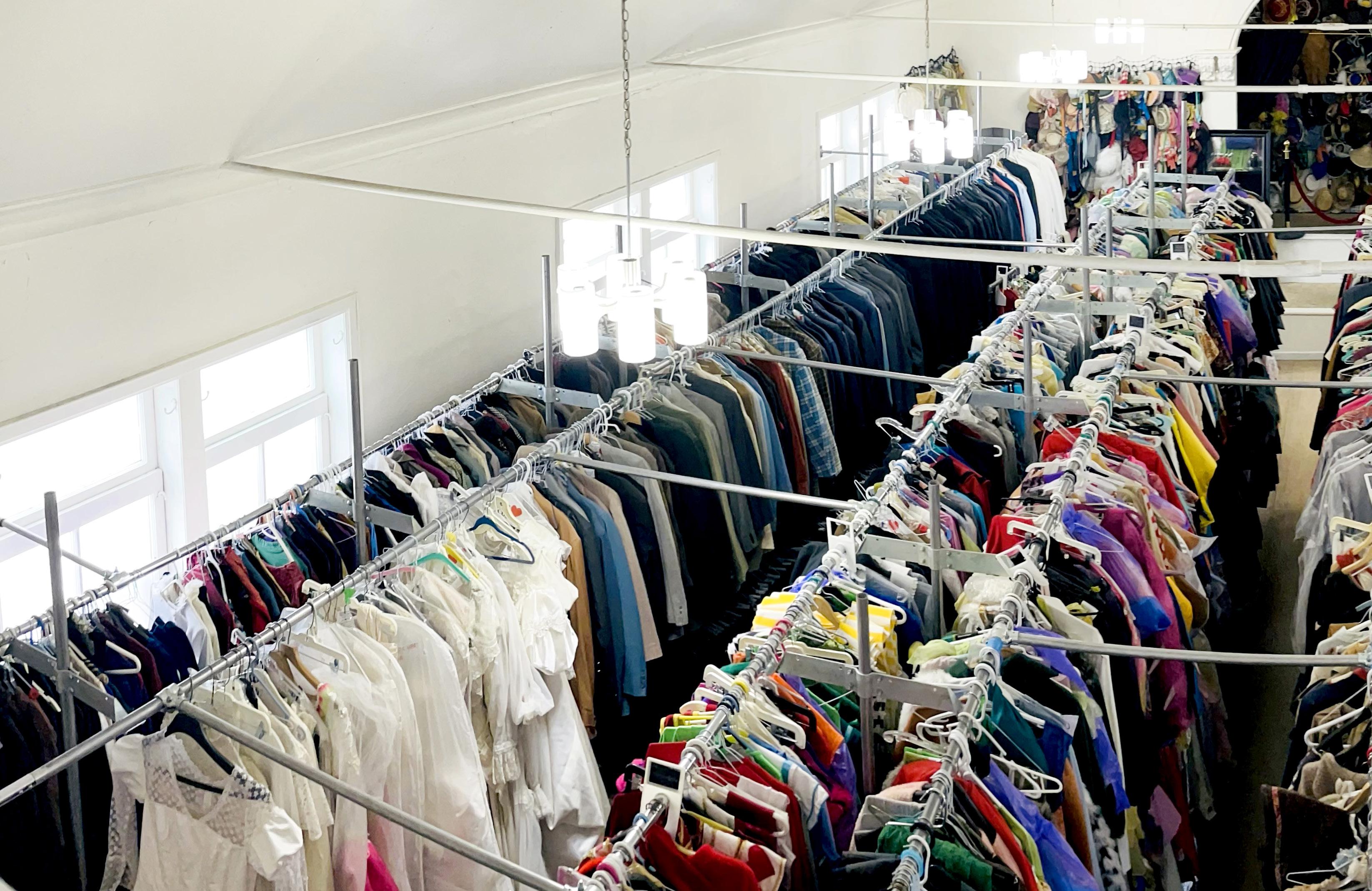
“It is utter chaos, but we know where everything is,” Anki half-
jokes. “This is the largest closet you are ever going to find.”
At the onset of the pandemic, Anki learned her business had to relocate from its Toronto home. She moved to a temporary warehouse location in Stoney Creek before finding the Kensington Avenue spot, which she describes as a lottery win.
When she came to visit, she learned the property was planned to become a retirement home. But the owners fell in love with bringing art to the neighbourhood. It took three months’ of elbow grease to combat the peeling paint of Gospel Hall, built in 1920.
Theatrix set up its operation in Hamilton in December 2021.
It was no small feat to sort, pack, move, unpack and set up more than 50,000 costumes, accessories and wigs, along with the racks, sewing machines and industrial steamers. It involved weeks of work and more than 15 truck trips.
“This is the best move we ever made,” she says. “We are really feeling the support from Hamilton businesses, performing arts, theatre companies, the music industry. We’ve already made some strong ties in this area. This is our forever home.”
Being embedded in Hamilton’s performing arts and film and TV production sectors is a great opportunity, says Anki.
“There is so much film and TV production happening here and they don’t want to go to Toronto for historical costuming. We are one of the only remaining, old-school costume stores still around.”
Theatrix is also establishing a clientele in Buffalo, after a longstanding costume store there burned down March 1 in a fire that killed a firefighter.
Theatrix includes a large custom-build department that works directly with directors and producers to create costumes. Theatrix show coordinators put looks together and custom designs pieces.
58 HCM MAY/JUNE 2023
They take pictures of every costume and get approval from directors.
A wardrobe department resizes, repairs, steams and assembles costumes for pick up or shipment.

“We are a team of six employees and we all wear many hats. We just make things happen,” says Anki.
At the time of our interview, Theatrix is working with productions of Beauty and the Beast, Legally Blonde, Mary Poppins, Annie, Shrek and Matilda
Anki is also owner and artistic director of Children’s Arts Theatre School in Toronto, which she founded over 30 years ago. She has led hundreds of productions starring kids from three to 18 years old and intends to build up a theatre school in Hamilton, too.
She has also started to hold costume design workshops to build local skills that will support the performing arts and film and TV industries.
“There is a lot to know about historical costumes, colour theory, assembling looks and moods for a show, appropriate materials, how to measure for costumes. We want this to be an educational hub,” she says.
“Costuming is so important to a production. We work diligently to fulfil the artistic vision of the director.”
Theatrix’s Crown Point West home includes rehearsal space downstairs and even a fully functioning 1950s-era kitchen. Both are available for rent.
Anki, a native of Toronto who now lives in Burlington, studied child psychology and theatre at Wilfrid Laurier University after getting the acting bug in elementary school. When she graduated, she bought a one-way ticket to London, England where she studied
at the Institute of Drama Therapy.
She also trained at the Royal Shakespeare Company during her nine years in London. In 1994, a year after returning to Toronto, she opened Children’s Arts Theatre School, which now operates in five locations.
“Directing children has always been a very strong calling for me. I was teaching at a drama school in Toronto at 13. It’s always been in my blood. I enjoyed performance but directing children is my calling.”
Theatrix has been in business since 1965 and Anki is the third owner. The first, Warren Hughes, opened a tiny little shop in Kensington Market. (Anki sees destiny in finding a new spot on Kensington Avenue.) The second owner, Peter Devita, moved the store right next to the Princess of Wales Theatre on King Street.
Devita is Anki’s relative and she contacted him to find out if he had any room to store some costumes for her school.
“We were having to hang costumes off the chandeliers. He told me that he was thinking about retiring and that I should buy the business. A week later, I signed to buy it.”
She later learned that Hughes’ grandchildren had been enrolled in her theatre program and that he had attended performances.
“I didn’t get to meet him before he died, but it just feels like I was meant to be owner of Theatrix.”
Anki has been touched by the donations that have come in, including military uniforms, fancy hats, and wedding wear. A neighbour even donated pristine antique furniture that looks perfectly at home in a meeting space in the front of the building.
“We just feel blessed to be here in Hamilton. The reception has been greater than anything we could have expected.” n
MAY/JUNE 2023 HCM 59
photo: supplied
Art in the everyday
TEXTILE ARTIST AMANDA RATAJ IS INTRIGUED BY THE ENDURING QUALITY OF FABRIC,

OVER TIME.
By Stephanie Vegh
Amanda Rataj brings a thoughtful spirit and a keen eye for light and shadow to a self-taught weaving practice that she has now been pursuing for over a decade. While she originally trained as a film-based photographer, creating images for mere looking became limiting when compared to the potential of objects that engage the hand and the body as a part of their everyday life. Textiles – the literal fabric of daily living –were much more appealing.
Originally hailing from Scarborough, Rataj moved to Hamilton five years ago after studying at OCAD University and building her early career in Toronto. She soon fell in love with the people and places of the city, and met Centre3’s executive director, Colina Maxwell, while working at Handknit Yarn Studio on James Street North. This introduction paved the way to her latest role as the inaugural textile studio technician at Centre3’s newest facility on Harriet Street.
The former site of Felton Brushes’ manufacturing facilities, Centre3’s latest studio expansion is a raw work in progress that reveals much of the building’s industrial history with heavy gears and wood-slatted rollers still suspended from the open ceiling. Below these burdened beams, folding tables prop up the beginnings of a textile studio that is already home to many looms and sewing machines.
So far, the most active users of this new space have been a group of newcomers and refugees attending a weaving program delivered in partnership with the Immigrants Working Centre. A rotating group of loyal regulars and new arrivals gathers weekly to practise their English and learn weaving by making their own table mats, hand towels and colourful rag rugs on the table-top looms. Rataj proudly shows off their progress as we explore the studio, drawing attention to the ambitious stripes in one student’s warp and other creative decisions made by relative beginners to the craft – people who do not identify as artists but are enthusiastically
60 HCM MAY/JUNE 2023
COMBINED WITH HOW IT INEVITABLY CHANGES
Am A nd A R AtA j is the in Augu RA l textile studio technici A n At c ent R e3’s newest fAcility on hARR iet s t R eet, whe R e she te Aches the ARt A nd c RA ft of we Aving. photo: supplied
making something uniquely their own.

Whether engaging visitors as an art educator at the Art Gallery of Ontario, or helping customers find the right yarn for their knitting projects at Handknit, Rataj has found an ideal path in enabling people from all walks of life to trust in their own innate creativity. “People think that being an artist is something special,” she explains, “but we put up this barrier that’s difficult for some to cross.” At Centre3, she sees the opportunity to make her craft more accessible to learners of all backgrounds and abilities, many of whom will not have the space or resources to set up a weaving studio at home.
She is guided as well by the legacy of her grandfather Rudolph Rataj who was the lead furniture designer for Brunswick Manufacturing, a Toronto company that created mid-century modern furniture for commercial clients from the 1950s to early 2000s. An accomplished craftsman certified in his native Germany, the elder Rataj also hand-built much of the furniture that shaped Amanda’s childhood, from bunk beds to a dining set that she would later inherit from her father.
“I never met my Opa,” Rataj explains, “but I’ve always had this intimate relationship and connection to his craftsmanship and the style and creative choices that he made when constructing beds, tables, chairs, and an entire cottage.”
This connection culminated in Generation, an exhibition at Craft Ontario’s Toronto gallery that honours the hard-edged simplicity of her grandfather’s dining chairs with the soft touch of new textiles that replace the aging 1970s upholstery of the original chairs. Her photographer’s sensibility informs her weaving, which captures the unexpected colours contained in shadows as well as the timeless patterns of traditional textiles. The deeper research that Rataj undertook into the history of Brunswick also yielded a broader appreciation for handmade items that embody craft and care and can travel across generations, like the dining table that Rataj’s father declared “strong enough to dance on.”
Longevity in Rataj’s eye doesn’t necessarily mean eternity; rather, she appreciates the way materials change through everyday wear, and how objects develop personalities by being used over time. After Generation closed at the gallery, the chairs returned home to resume their everyday purpose
as dining furniture. Their wear and tear will become a part of the work, changing through the years of sunlight, sitting and spills to come. “I don’t need it to be a perfect museum piece that looks the same for its entire lifespan.”
The enduring potential of this work is frustrated in part by a market flooded with cheap goods that undermine the value of handmade craft; a tea towel priced to the true value of materials and labour can be shockingly expensive when compared to its factory-churned version. As a result, Rataj has resisted the path of producing objects for sale in favour of sharing her skills with others – as an educator and facilitator, but also as a creator of patterns that can be purchased by others to make their own. In much the same way that one can share a recipe, Rataj provides directions that allow the home weaver to duplicate her designs, or use these as a foundation to improvise their own expressive idea.
This approach to weaving, one that places sharing and teaching before making and selling, is the generous heart of Amanda Rataj’s practice – an aspirational spirit that places art and the means of its creation calmly and confidently in the hands of others. n

MAY/JUNE 2023 HCM 61
“Profiles of the daring individuals who ... made Canada the world leader in psychedelic therapy” Psychedelia.live
amazon.com/author/markcoakleybooks
Peo P le think that being an artist is something s P ecial, but we P ut u P this barrier that’s difficult for some to cross.”
a manda r ataj
Am A nd A R AtA j’s exhibition generation , At C RA ft o ntAR io’s to R onto g A lle Ry, honou R ed the h AR d-edged simpli C ity of he R g RA ndfAthe R ’s dining C h A i R s with the soft tou C h of new textiles. photo: Jocelyn Reynolds/ cR aft o nta R io
A GOLDEN DIRECTION
BRAD GERMAIN IS WELL KNOWN FOR FREQUENTLY TAKING NEW MUSICAL PATHS WITH HIS LIST OF PAST PROJECTS. HIS NEW BAND GOLDEN FEATHER IS INFLUENCED BY STEELY DAN, GRATEFUL DEAD AND OTHERS WHILE EXPLORING A ‘JAM BAND’ APPROACH, WRITES JAMIE TENNANT.

Jam bands had their heyday in the 1970s. The jam band scene, however, will be familiar to folks who lived through the ‘90s. It brings to mind Phish, Blues Traveler, Widespread Panic, Dave Matthews Band, The String Cheese Incident, tie-dye, hacky sack. It all comes to mind when remembering the nouveau hippie movement of the ‘90s. Golden Feather hews closers to the long-form improvisation of artists like the Grateful Dead and the Allman Brothers than the sounds of Dave Matthews.
You could, if you really wanted to, call Golden Feather a ‘‘jam band.” You wouldn’t be wrong. You just wouldn’t be exactly right, either.
Fans of musician Brad Germain might be surprised by his new band’s direction. Then again, maybe not; if anything has defined Germain’s career to date, it’s the idea of change. His first group, The Marble Index, reflected his love of underground, alternative music. Spirits galloped off from there, but in a new-wavier direction. The Dinner Belles were full-tilt country, while the Cosmos Quartette necessitated genre-fusion descriptions such as “chamber-folk.”
It was Germain’s friendship with drummer Steve Kiely (Monster Truck, the Reason) that fomented this new sound.
“(Kiely and I) spend time vacationing together, that’s where all the seeds came from,” says Germain. “We go to this farm north of Perth, Ontario, and we would have these long bricks of time together. Steve’s partner Justine and her parents are mega-Deadheads, so that farm is filled with just boxes and boxes of Dead shows on tape.”
Together, Kiely and Germain started to write songs that featured stretches of open space for long-form improv.
“Listening to (Dead) tapes and wanting to try 10-, 15-minute songs – that appealed to me,” says Germain.
In their (thus far) short career, Golden Feather has allowed themselves to expand and contract, to welcome new members and to branch off in new directions. Recently, says Germain, the band has leaned more towards R&B and boogie-woogie. “We always did straddle a line through a Steely Dan-type world, where the music has some of that tight funkiness,” he says. “We’re moving more towards that.”
Of course, the band could continue to move right past that into new, unexpected sounds. What is likely to remain, however, is the jam, which brings us back to the idea of the jam band.
“We fit in it to a degree because we extend things and we have a way of rolling along, like jam bands will,” Germain says. “The thing that I feel will separate us from the pack is the harmony singing and the actual songs themselves. They’re not just opportunities for us to jam on a lick. It’s a song first.”
Though what they’re doing can come across as retro, Golden Feather somehow cuts through the nostalgia. It might be because, despite all these references to the Dead, the main songwriters aren’t constrained by the influences of classic rock, folk rock, or other jam bands. Germain spent his teenage years steeped in the music of Pavement and Nirvana; Kiely was a fan of Rage Against the Machine and the Red Hot Chili Peppers. The impact of these newer influences can be felt more than heard; you’d have a hard time picking out a Thurston Moore-inspired guitar lick, but Germain promises they’re there, part of the harmonic stew cooked up by band members with diverse backgrounds.
Golden Feather plans to start recording their first official full-length album in May. In the meantime, they will focus on something less traditional. Golden Feather recorded a live set at Hamilton’s Bridgeworks in late 2022. The show – the last one with guitarist Chris Wheeler, who amicably split from the group afterwards – was captured on audio and video with four cameras (directed by long-time filmmaker and music enthusiast Mitch Fillion, of Southern Souls fame). The project, titled Welcome/Release, will be available via Sonic Unyon in late June. It will be released both track-by-track and in full, in both audio and video formats. n
NEED TO KNOW
Band: Golden Feather
Members: Brad Germain (guitar, vocals); Steve Kiely (drums, vocals); Gareth Inkster (keyboards, vocals), Ronson Armstrong (bass), Murray Heaton (saxophone)
Releases: Light on Water EP (2020), Now & Then EP (2022), various singles

MAY/JUNE 2023 HCM 63
LEFT: Golden Feather is, F rom le F t: m urray h eaton, r onson a rmstron G , Brad Germain, Gareth i nkster and s teve k iely.
photo: supplied
Art and About
A MOMENT AT THE MIC
Have a song, comedy set or poem you’re itching to debut, but no audience? The Staircase is ready to provide one for you at its monthly open mic nights. Performers simply need to sign up for a 10-minute time slot upon arriving and then wait for their chance to take the cozy stage. Relay Coffee is in the house providing coffee and snacks, so expect a fully caffeinated and alert crowd cheering you on in the welcoming air of the theatre. Check out the website for details and more dates. May 26 (recurring). staircasehamilton.com
CORRIE LOVE
Fans of the venerable Coronation Street are in for a treat when two stars of the series drop in for a bit of storytelling and a few surprises. Recently married in real-life, Sally Carman (Abi Franklin) and Joe Duttine (Tim Metcalfe) are dropping in at the Westdale Theatre for a stop on their Canadian tour, and fans will delight in the up-close and personal takes on a series whose popularity has reached iconic status. Niagara Falls may be the honeymoon capital, but Hamilton has the Honeymooners. Coronation Street the Honeymooners Tour, June 4. thewestdale.ca
DUNDURN DECORATION
BIG 80s ENERGY
Were you fortunate enough to experience the joys of 80s music the first time around (hi!) or were you introduced to the magnitude of its awesomeness at a different time? Either way, fans of that dot on the musical landscape are invited to hit the Casbah’s dance floor on the first Saturday of each month, when DJs Mark and DMurk host their Risky Biz 80s night. The music that came out of that decade was eclectic and revolutionary – and having a monthly celebration of this fact is totally rad. See you there. 19+ June 3 (recurring). casbahlounge.ca

WORK AS A GROUP, INDIVIDUALLY
Being an artist can sometimes be a solitary endeavour, yet at the same time, creativity breeds creativity. With this dichotomy in mind, the Youth Art Collective regularly welcomes young artists 14+ to come together to share their skills and hone their craft with like-minded cohorts at art-making meetups. The casual drop-in events are offered each month at the Art Gallery of Hamilton, and offer a welcoming and inspiring space for sketching, painting and creating en masse. May 24 (recurring), 6:30-9 p.m. artgalleryofhamilton.com
The Hamilton Military Museum invites you to spend Decoration Day in the shadow of the castle at Dundurn Park. Since its beginnings in 1890, this Canadian holiday recognizes veterans of Canada’s military, and the Museum commemorates the day – and our veterans – by offering visitors free admission, the chance to view authentic military vehicles, participate in hands-on activities, and experience historic presentations. Plan a visit and be sure to check out the displays from a wide variety of military groups, all to whom we owe our thanks. June 11, Dundurn Park. hamilton.ca
LA CIRQUE
There is a party coming to Hamilton this June, with a special je ne sais quoi flair. Organized and run by a dedicated group of professionals and volunteers, the circus-themed FrancoFEST is a fun weekend-long arts and culture festival with the goal of showcasing a wide range of artists from the Francophone community. The talents of the French-speaking singers, acrobats and artists from Ontario and beyond are too impressive not to be shared – so head to the park this summer and prepare to have your horizons expanded in a whole new language. Á bientôt! June 16-18, Gage Park. francofesthamilton.ca
64 HCM MAY/JUNE 2023
There is never a shortage of fun and inspiring arts and culture events in Hamilton and Burlington. Here are a few of our favourite local happenings.
scan the qr code Plan your weekend, your week and your month with our t hings to d o listings! hamiltoncitymagazine.ca
TONIGHT,
THIS WEEKEND, NEXT MONTH?

what to do?
LET US HELP WITH THAT.
HAMILTON CITY MAGAZINE HAS CURATED EVENTS AND ACTIVITIES FROM DOZENS OF ORGANIZATIONS, PROMOTERS, CLUBS AND CULTURAL INSTITUTIONS IN THE HAMILTON AND BURLINGTON AREA.

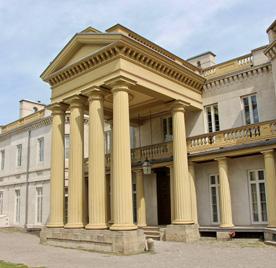











Instead of endlessly searching the internet, you only have to go to one place: hamiltoncitymagazine.ca. Check out the Things To Do section on our homepage menu and use the dropdown menu Find An Activity to search by the type of activity or event you’re craving. It’s all there for you – including our feature stories that highlight local events, found under Happening Now.

TOMORROW,
things to do scan the qr code to be taken direct LY to
and activities L
the events
anding page.
hamiltoncitymagazine.ca































































































 By Natha N Whitlock | portrait B y jo N eva N s for hcm
By Natha N Whitlock | portrait B y jo N eva N s for hcm




















 a llen
a llen















 Kenadie St. Jame S , pictured at right with her dog Lupin, says “drag isn’t about wanting to be a woman. i t’s about expressing yourse L f through a feminine out L et.”
Kenadie St. Jame S , pictured at right with her dog Lupin, says “drag isn’t about wanting to be a woman. i t’s about expressing yourse L f through a feminine out L et.”
 k enadie s t. j ames
k enadie s t. j ames



 By Meredith M ac Leod
By Meredith M ac Leod























